




america’s electric grid could be impelled toward increasing instability amid the net-zero emissions agenda that’s being driven by government and corporate policies.
The accelerated push to demonize fossil fuels shifts more dependence to electricity, which burdens an already ailing grid.
At the federal level, the electrification effort has included heavy subsidies for electric vehicles and charging stations, as well as a contemplated ban on gas stoves.
On top of government efforts comes the environmental, social, and governance (ESG) movement, which has succeeded in bullying corporations and public utilities into compliance with its net-zero emissions agenda.
“Running while we’re tying our shoes is the analogy I would give,” John Moura, director of reliability assessment at the North American Electricity Reliability Corp. (NERC), told Epoch Insight. The NERC is charged with regulating electric utilities to ensure that they can deliver electricity whenever it’s needed.
“In the winter, one of the particular challenges with solar is that peak electricity demand is happening usually when the sun is down, early morning, or early evening,” Moura said. “You can add as much solar as you want, but it wouldn’t be there to contribute to that time period and serving demand.”
Read Epoch Insight’s in-depth report by Kevin Stocklin to find out more about the outlook for America’s energy future.
 Jasper Fakkert Editor-in-chief
Jasper Fakkert Editor-in-chief


The rush toward renewables via a net-zero agenda could be a risky gamble with America’s grid.
(USPS21-800)IS PUBLISHED WEEKLY BY THE EPOCH MEDIA GROUP, 9550 FLAIR DR. SUITE 411, EL MONTE, CA 91731-2922.
PERIODICAL POSTAGE PAID AT EL MONTE, CA, AND ADDITIONAL MAILING OFFICES.
POSTMASTER: SEND ADDRESS CHANGES TO THE EPOCH TIMES, 229 W. 28TH STREET, FLOOR 5, NEW YORK, NY 10001.
22 | South Africa
Nelson Mandela’s party faces an unprecedented reckoning as the nation spirals.
38 | A Timeline
Classified documents were found in Biden’s home and prior office.
56 | Climate Influence
A new organization pays reporters to spread climate ideology.
58 | Global Dominance
Some believed capitalism would gradually deliver freedom to China.
59 | China Committee
There’s a new sheriff in town, and his name is Rep. Mike Gallagher.
60 | US Economy
Jobs data and spending measures seem to contradict one another.
61 | National Security
The U.S. government seeks to outlaw TikTok but faces obstacles.
62 | Monetary Policy
Why are global central banks adding gold to their reserves?
63 | Investment
Is this the beginning of a multiyear bull market in gold?
America’s electric grid could be driven toward instability amid a net-zero agenda.
The United States officially reached its statutory debt limit of $31.381 trillion on Jan. 19 as was predicted by Treasury Secretary Janet Yellen in a letter to Congress on Jan. 13. The Treasury Department will now have to implement extraordinary measures to prevent default on the national debt.
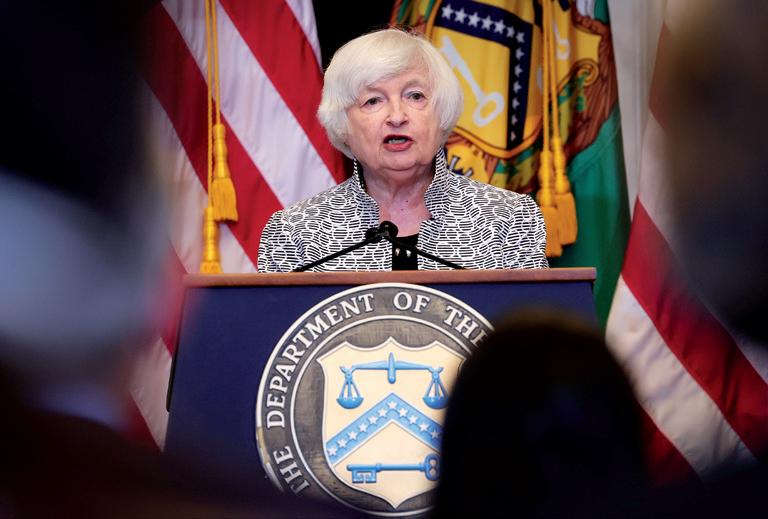
64
The CCP’s unrestricted warfare is building its dominance in the Pacific.
68 | Choose Your Mission
A life well lived requires having a specific focus and goal.
70 | Your Own Winery Set in British Columbia, this estate features winemaking and horses.
72
| A Sparkling Winery
Santa Rita’s winery is a great place to unwind and relax.
75 | Hoist an Ale Delight your guests, and yourself, with these delicious mulled ales.
76 | Bucket-List Golf
Consider these epic courses for a most memorable golf vacation.
79 | Let Your Light Shine Keeping a compact flashlight in a bag or briefcase is a bright idea. 83 | Lend a Helping Hand How to be that exemplary volunteer every organization dreams of.
VISITORS TAKE PHOTOS OF THE MANHATTAN skyline at the glass-box observation deck at SUMMIT One Vanderbilt in New York on Jan. 16. The observation deck features an all-glass enclosed elevator, transparent glass boxes, and a room covered entirely with mirrors.
 BY ED JONES/AFP VIA GETTY IMAGES
PHOTO
BY ED JONES/AFP VIA GETTY IMAGES
PHOTO


Among bigger issues, Southwest Airlines is still fighting against a prolife former employee. 14
Hormone therapy “almost killed me,” says a California man with a heart defect. 32

Nelson Mandela’s party faces an unprecedented reckoning as South Africa is devastated by corruption. 22
A total of 331 police officers were shot last year while on duty, a 13 percent increase from 2019, according to the National Fraternal Order of Police.
Nevada has the least affordable housing in the country, according to the Department of Housing and Urban Development. Among low-income renter households in the state, 81 percent face severe cost burdens.
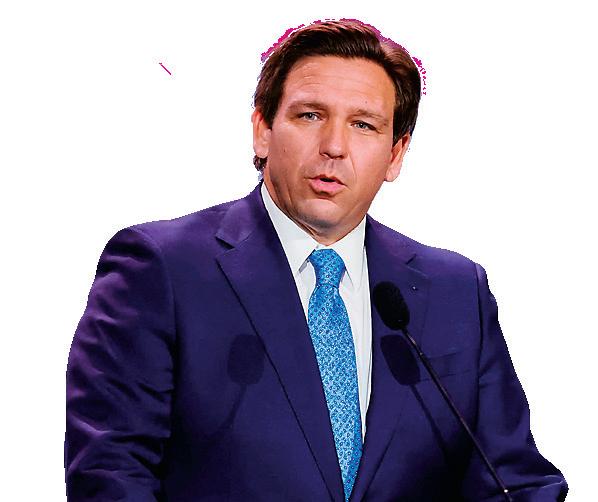
Just 2 percent of U.S. counties accounted for 56 percent of murders in 2020, according to a recent report by the Crime Prevention Research Center. Cook County in Illinois recorded the highest number of murders, at 775.
Chicago Public Schools had 1,735 reported adult-on-student sexual misconduct cases in the past four years, according to the Chicago Board of Education’s Office of Inspector General.
1,600 CHILDREN — More than 1,600 children aged 5 to 11 experienced a systemic reaction such as fever or diarrhea after receiving an updated Pfizer or Moderna COVID-19 vaccine, according to the Centers for Disease Control and Prevention.
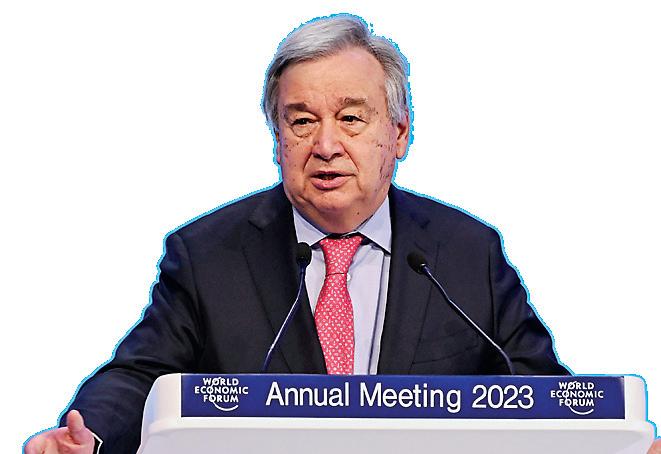
“Many parts of the world face recession, and the entire world faces a slowdown.”
“When the world lost its mind, Florida was a refuge of sanity, serving strongly as freedom’s linchpin.”U.N. Secretary-General António Guterres, during the World Economic Forum’s 2023 summit.
PRESIDENT JOE BIDEN has said that AR-15 rifles wouldn’t help Americans in an armed conflict with the federal government.
People wear masks amid the COVID-19 pandemic in Central Park in New York on May 16, 2020.

HOUSE REPUBLICANS have introduced a bill to end the COVID-19 public health emergency nearly three years after it was implemented nationwide.
Last week, the Department of Health and Human Services (HHS) confirmed that it would again extend the health emergency for another 90 days, according to a declaration issued by HHS Secretary Xavier Becerra. The emergency has been renewed about a dozen times since it was implemented under the Trump administration in early 2020.
Rep. Brett Guthrie (R-Ky.) on Jan. 18 proposed the Pandemic Is Over Act, placing more pressure on the Biden administration to rescind the emergency measure. About three months ago, President Joe Biden told a “60 Minutes” reporter that he believes “the pandemic is over,” prompting White House officials to scramble to clarify his stance.
WHITE HOUSEA GOVERNMENT WATCHDOG GROUP has filed an ethics complaint claiming that President Joe Biden misused taxpayer-funded resources by having White House lawyers address his own legal crisis.
In the complaint sent to the Office of Government Ethics, the group Protect the Public’s Trust took issue with the involvement of the White House Counsel’s Office in the ongoing fallout from Biden’s alleged improper handling of classified documents.
“The White House Counsel’s Office is not the President’s personal law firm. It does not represent the President in purely personal matters that are separate from his role as President,” the group wrote.
“Yet, the White House Counsel’s Office appears to be acting as lawyers to Joe Biden, private citizen, rather than President Biden in this matter.”
Federal law prohibits employees from using their official position for personal gain, according to the Department of Justice.
Biden made the comments during the National Action Network’s annual Martin Luther King Jr. Day breakfast in Washington, where he vowed to ban what he called “assault weapons,” referring to semiautomatic sporting rifles in the style of an AR-15.
“I love my right-wing friends who talk about ‘the tree of liberty is watered with the blood of patriots,’” he said. “If you need to worry about taking on the federal government, you need some F-15s. You don’t need an AR-15.”
TWO REPUBLICAN HOUSE lawmakers landed committee assignments on the House Committee on Oversight and Accountability after having been stripped of them in the previous Democrat-controlled Congress on separate occasions in 2021.
Reps. Marjorie Taylor Greene (R-Ga.) and Paul Gosar (R-Ariz.) had both been stripped of their committee seats in 2021 over social media posts they had made.
Their reinstatement fulfills a promise by House Speaker Kevin McCarthy (R-Calif.), who said back in November 2021 they would regain their committee posts for the 118th Congress if Republicans won the House.
Stripped of Them Previously
Saudi Arabian Minister of Finance Mohammed Al-Jadaan (C) attends the Euromoney conference in Riyadh, Saudi Arabia, on May 2, 2018.

SAUDI ARABIA , the world’s largest crude oil exporter, is considering trading in currencies other than the U.S. dollar, a kingdom official has revealed.
Mohammed Al-Jadaan, Saudi minister of finance, told Bloomberg TV in Davos, Switzerland, that officials are open to potentially utilizing other currencies as the energy juggernaut bolsters relations with its strategic partners.
“There are no issues with discussing how we settle our trade arrangements, whether it is in the U.S. dollar, whether it is the euro, whether it is the Saudi riyal,” he said. “I don’t think we are waving away or ruling out any discussion that will help improve the trade around the world.”
TAIWAN’S DEFENSE MINISTRY has stated that it will allow women to enroll in military reservist training for the first time as the self-governing island seeks to bolster its forces amid threats posed by the Chinese communist regime.

The ministry will allow about 200 discharged female military personnel and 500 male reservists to participate in the voluntary training, which will begin in the second quarter of 2023, Taipei Times reported.
The dual-track training program, which began last year, consists of two weeks of training as opposed to the previous five to seven days. Under the new program, volunteer reservists can choose a one- or two-week training period.
RUSSIA’S CURRENT ACCOUNT SURPLUS hit a record high in 2022, the country’s central bank says, as a fall in imports and robust oil and gas exports kept foreign money flowing in despite Western efforts to isolate the Russian economy.

Russia’s current account—a measure of the difference between all money coming into a country through trade, investment, and transfers, and what flows back out—came in at $227.4 billion, up 86 percent from 2021.
Russian imports fell sharply last year amid an exodus of Western firms after the West imposed sweeping sanctions on Moscow for its invasion of Ukraine.
But the Kremlin has sought to replace revenues lost from its oil and gas exports to Europe with a pivot to China, India, and other Asian countries.
THE NUMBER OF PEOPLE being held on remand awaiting trial in England and Wales has risen to 14,507, the highest it has been for 50 years and a jump of 44 percent in 18 months, according to a committee of UK lawmakers.
The backlog of trials caused by the COVID-19 pandemic and last year’s barristers’ strike have been blamed for the rise.









1. A horse rider braids his horse’s mane ahead of a traditional ritual honoring San Antonio Abad in San Bartolome de Pinares, Spain, on Jan. 16. Horse riders jump over bonfires to honor the patron saint of domestic animals.

2. A man pays his respects to former King of Greece Constantine II, who died at 82, at his funeral at the St. Eleftherios chapel in Athens on Jan. 16.

3. A performer spits fire during the Grebeg Sudiro festival, a prelude to the Lunar New Year celebrations, in Solo City, Indonesia, on Jan. 15.

4. Girls carry a gas cylinder along a street in Kabul, Afghanistan, on Jan. 17.

5. Old Pack Horse Bridge in Carrbridge, Scotland, on Jan. 18.
6. Men tackle a bull as they participate in the annual bull-taming sport of jallikattu during the harvest festival of Pongal, in Avaniyapuram, India, on Jan. 15.



 A Southwest Airlines passenger jet lands at Chicago Midway International Airport on Dec. 28, 2022.
A Southwest Airlines passenger jet lands at Chicago Midway International Airport on Dec. 28, 2022.
 BY JANICE HISLE
BY JANICE HISLE
losing case against fired worker who views on social media
In the throes of a Christmastime operational meltdown, Southwest Airlines filed for a new trial in a high-profile employee rights case—a decision that makes critics question the airline’s sense of priorities.
The airline claims that a federal judge and jury erred when deciding in favor of a flight attendant, Charlene Carter. After being fired for using social media to express her pro-life views, Carter sued to get her job back. Arguing free-speech violations, Carter won a nationally publicized verdict this summer.

Southwest’s latest filing opposing Carter’s victory landed on Jan. 2 amid one of the most embattled periods in the airline’s 51-year history.
In late December 2022, Southwest canceled more than 16,500 flights as a winter storm overloaded the airline’s outdated computer system and strained its internal processes. Southwest took far longer to recover from the storm than its competitors did.
The company’s epic performance failure inconvenienced millions of people. The airline stands to lose up to $835 million, faces federal investigations, and has been hit with a class-action lawsuit over ticket-refund disputes.
Against that backdrop, critics are trying to understand why Southwest would continue bothering with Carter’s case. They wonder, shouldn’t the company focus on fixing problems that contributed to the massive meltdown?
They also think the airline is committing a public-relations blunder by digging in its heels against Carter.
As one employee put it, the case looks like a David-versus-Goliath matchup— pitting a multibillion-dollar corporation against a lone employee who wants to return to her job.
Some see the Carter case as emblematic of deeper employee–management tensions that have now been laid bare.
The Epoch Times requested comment from attorneys on both sides in Carter’s case but received no reply from those representing Southwest.
In court records, the company insists it has done no wrong to her. Southwest also says it feels justified in its decision to continue fighting against Carter in court. Simultaneously, the airline has
taken court-ordered steps to return her to the workforce.
People who have followed Carter’s case liken it to “a canary in a coal mine,” an early warning that internal conditions were turning toxic at Southwest.
The case dates back five years. In hindsight, employees say, that was a few years after they started feeling that the airline was veering away from the employee-friendly principles that propelled Southwest’s success.
The airline’s beloved founder, Herb Kelleher, is credited with laying that foundation. He infused love into “the LUV airline”; the carrier’s stock ticker is LUV because it’s based at Dallas Love Field.
Kelleher was famous for his folksy interactions; Carter is among the many employees who remember him fondly.
On Jan. 3, the fourth anniversary of
Kelleher’s death, Carter posted a picture of him on Facebook.
“You were the reason I wanted to work for SWA,” Carter wrote, adding that she and others sorely missed him. “I will be forever grateful to have gotten the chance to work for the most amazing boss!”
When Carter was hired in 1996, Kelleher was CEO. After almost two decades in that role, he stepped aside in 2001 after a cancer diagnosis. Kelleher remained chairman until 2008.
In 2017, long after Kelleher’s tenure ended, Southwest fired Carter for using social media to send pro-life messages to her union president.
Some of Carter’s peers insist she never would’ve faced discipline if Kelleher-style management had remained in force. They say he wouldn’t have condoned some tactics that came to light during Carter’s case.
Current and former Southwest employees provided their views of Carter’s case on condition of anonymity, fearing repercussions.
Initially, the Carter case was little-known among employee ranks.
More people learned about Carter and the case this summer after the Dallas jury’s verdict attracted national media attention. That ignited more employee interest and spawned a Facebook group focusing on the Carter case transcripts.
Recently, all of Carter’s peers received court-ordered notifications about the case.
Some now see Carter’s case as a cause célèbre. Supporters see her as a standard-bearer for free speech rights that seem to be under constant attack.
They say coworkers have been investigated for even accidentally using “wrong pronouns” for transgender people.

Multiple sources said that the air-
line is even cracking down on employees for years-old social media posts on topics completely unrelated to the airline business.
Some employees allege that workers with conservative, traditional values seem to be singled out for discipline. At the same time, those considered “diverse”—ethnic minorities or those claiming transgender status—often have been allowed to “skate.”
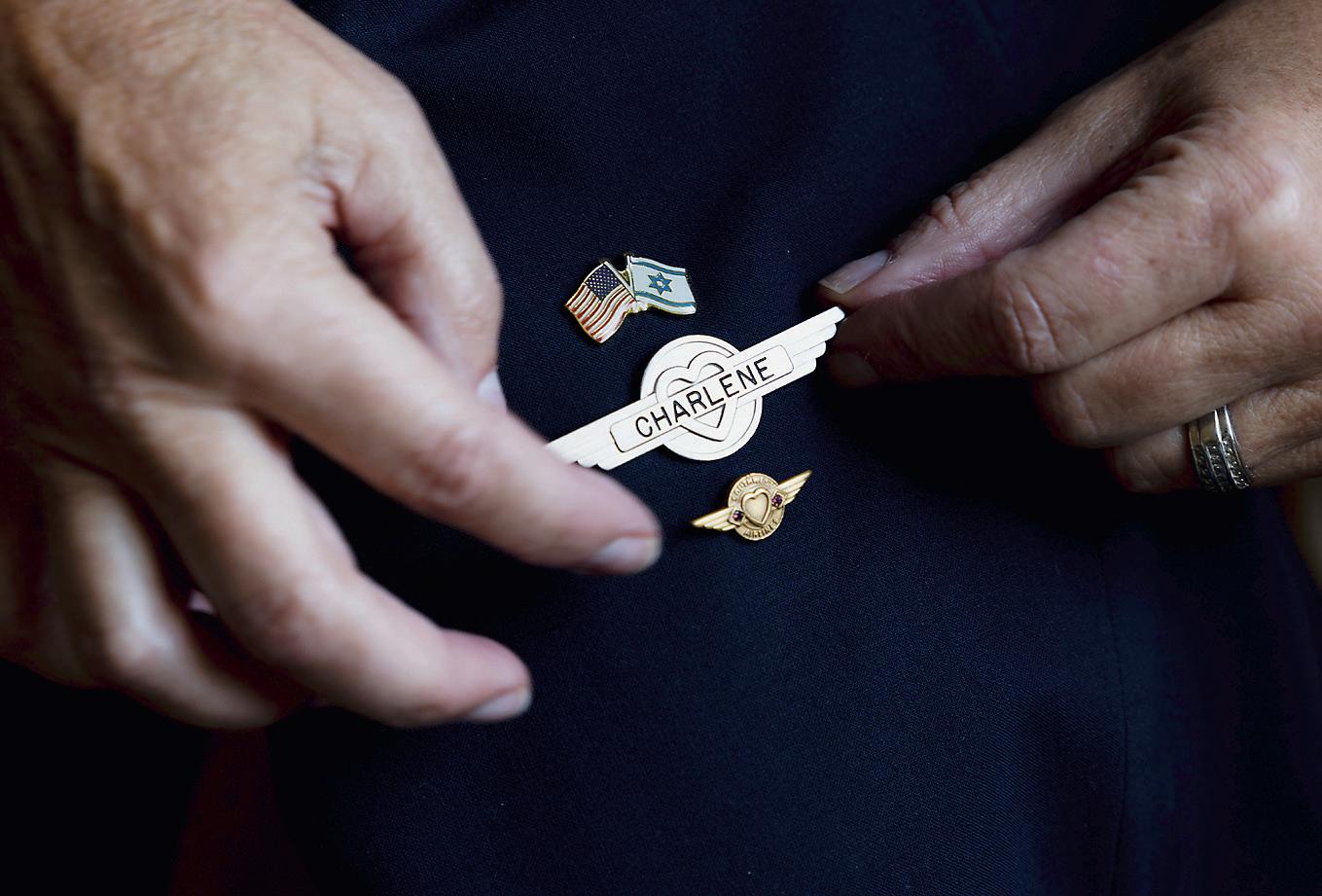
The company’s “diversity, equity, and inclusion” programs encourage people to express themselves and bring their “authentic selves” to work. But those DEI policies appear to pertain mainly to people in preferred categories, some employees say.
Southwest’s alleged adherence to these
“woke policies” was detailed in an extensive Epoch Times report this summer.
The company’s continued pursuit of court action against Carter seems to show “the management disconnect” between Southwest’s upper echelon and its workforce, a former Southwest employee said.
As one worker said, the case’s eventual outcome could affect employees’ morale companywide: “As goes Charlene, so go the employees.”
An April 2022 version of Southwest’s social media policy states that employees can be disciplined or fired for posting anything on social media that might affect the workplace “in any way.”
Some Southwest employees allege that workers with conservative, traditional values seem to be singled out for discipline. At the same time, those considered ‘diverse’ often have been allowed to ‘skate.’
Incensed by her union’s activities connected to a pro-abortion group, Carter publicly posted videos of aborted fetuses on Facebook. She also sent those to her union president in a private Facebook message.
Then-President Audrey Stone reported Carter to Southwest management.
Deeming Carter’s messages “offensive,” the company fired her. Carter lost her job despite an unblemished record of nearly 21 years.
Carter said she holds intensely personal religious reasons for opposing abortion.
Federal laws protect American employees’ rights to religious-based expression. In addition, the Railway Labor Act protects union-related speech among U.S. airline employees.
Citing those protections, a nonprofit legal defense foundation filed a federal lawsuit on Carter’s behalf.
Her lawyers obtained emails that revealed stunning interactions between union activists and company managers.
One activist said he promoted “targeted assassinations”—job terminations— of the union’s enemies. Activists would scour “targeted” employees’ social media accounts, looking for possible violations of company policy. Then they’d report those posts to management.
Following a trial in mid-2022, jurors found that Southwest and the union, Transport Workers Union of America Local 556, violated Carter’s federally protected rights to express her Christian pro-life beliefs and to criticize the union.
Judge Brantley Starr approved monetary damages approaching $1 million for Carter a month ago. He also ruled that she was entitled to have her job back.
Now, Southwest is asking the judge to find fault with his own rulings and grant a retrial in U.S. District Court in Dallas.
Carter’s legal team says such a motion has little chance of prevailing. But, by filing its new-trial motion just before an appeals deadline, Southwest bought more time to file with the 5th U.S. Circuit Court of Appeals, as threatened, Carter’s attorneys say.
Southwest denies wrongdoing in Carter’s case.

The airline says it upholds employees’ rights to communicate “in a civil and respectful manner.” Southwest fired Carter after deciding she ran afoul of that standard.
In a Jan. 2 court filing, Southwest asserts that the jury’s decision favoring
Carter was based on flawed instructions and insufficient evidence.
Southwest also faults Starr for “unfair management of the trial and other legal errors.”
The airline complains that Starr granted extra time to Carter’s lawyers, “improperly limited Southwest’s communications with its witnesses during trial,” and failed to “adequately explain” his refusal to throw out the case.
Southwest filed its motion for a new trial right before the expiration of a 28day time limit after Starr specified how the jury’s will would be imposed.
On Dec. 5, 2022, the judge granted Carter $600,000 in compensatory and punitive damages, with Southwest and Local 556 each paying half. Those were the maximums the law allows, far below the $5 million that jurors voted to award Carter. They were unaware of the limits.
Starr also ordered Southwest to pay Carter $150,000 in back pay plus another $60,000 or so in prejudgment interest. In a separate order, Starr sanctioned Southwest about $25,000 for failing to help make a witness available.
In mid-December, Carter’s lawyers from the National Right to Work Legal Defense Foundation (NRTW) filed a motion calling for Southwest and Local 556 to absorb costs incurred in Carter’s defense.
That motion seeks about $2.8 million in attorneys’ fees and costs.
The two defendants, Southwest and Local 556, filed court paperwork asking Starr to suspend the monetary portions of his order, pending appeal. The defendants jointly posted a bond of $4.8 million, estimated to be the “upper limit”
As ordered, Southwest has taken steps to reinstate Carter. But Carter’s legal team accuses the airline of violating part of Starr’s order—an allegation Southwest denies.
On Dec. 30, 2022, NRTW filed a motion asking the judge to hold the airline in contempt of court. NRTW also wants Starr to fine Southwest. But Southwest later countered that it had “fully complied” with the judge’s order.
The controversy leading to the contempt motion began on Dec. 20—just before the winter storm that touched off Southwest’s widespread cancellations.
On that date, Southwest had arranged for Carter to catch a flight from her home in Colorado. The airline summoned her to the company’s Dallas headquarters as a step toward reinstating her.
As Carter was claiming her employee badge, the airline and Local 556 sent notices about Carter’s case to all 17,000 Southwest flight attendants, including Carter.
Starr had ordered those notifications, but Carter didn’t know when they might be sent.
A friend of Carter, who works at the airline, said the notices caught Carter off-guard. So did some of the content. “It was awful,” her friend said. The wording seemed to throw cold water on Carter’s eagerly anticipated return to work.
On NRTW’s advice, Carter, 57, declined to be interviewed for this story.
‘Thumbed Their Nose at the Judge’
While Local 556 wrote a three-sentence notification closely mirroring the language in Starr’s order, Southwest wrote two notices.
One was a short email with court decisions attached. The other was a pagelong memo from Southwest’s legal department.
NRTW takes serious issue with much of what the airline said.
“They were supposed to let everyone else know at Southwest Airlines that they wouldn’t do this type of thing to anyone else,” Mark Mix, NRTW president, told The Epoch Times. “And yet they thumbed their nose at the judge in that case.”
He said the airline, in its notices, failed to own up to “what they did wrong, and the fact that they won’t do it again.”
Instead, Mix said, Southwest essentially told its employees, “We didn’t do anything, but we’ve got to mail you this notice ... [and] we object to what Charlene did.”
Southwest, in one of the notices,
wrote, “[The judge] ordered us to inform you that Southwest does not discriminate against our employees for their religious practices and beliefs.”
NRTW lawyer Matthew Gilliam complained about this wording in a letter to Southwest’s lawyers.
The company told employees that Carter’s case involved social media use in a way that created “unnecessary tension” in the workplace and “crossed the boundaries of acceptable behavior.”
Southwest described her posts and messages as “inappropriate, harassing, and offensive.”
The airline said it was “extremely disappointed” in the case’s outcome. However, the company promised to “implement the judgment as we work through the appeal process and await a final ruling.”
In response to the litigation, Southwest said, “We are currently refreshing our social media policy.”
A jury found the airline did discriminate against Carter “for her protected speech about religion and unions,” Gilliam said. But the company’s notices suggest that Southwest “does not and has never engaged in religious discrimination.”
Gilliam called the airline’s message “patently false” and a misrepresentation of the outcome of Carter’s case.
In addition, the airline’s announcement “violates the court’s injunction against treating Carter differently and less favorably,” Gilliam alleged.
The airline also “disparaged” Carter in the notice, Gilliam said.
Considering how that policy was used in Carter’s case, “Southwest’s memo chills and restrains employees’ religious beliefs and expression,” Gilliam wrote.
He accused Southwest of declaring itself “the arbiter of what protected conduct the company is willing to permit, as it did with Carter.”
Gilliam also wrote, “The entire communication makes clear that nothing has changed as to Southwest’s enforcement of its social media policies.”
The company concluded its notice by stating: “Each and every employee is valued, and we must work to ensure that everyone is comfortable in their work environment ... regardless of our differing opinions. It’s the Southwest way.”
A pro-life campaigner displays a plastic doll representing a 12-weekold fetus. Charlene Carter was fired for using social media to express her pro-life views.

One Southwest worker says that the eventual outcome of Carter’s case could affect employees’ morale companywide.
Company ‘Strongly Disagrees’ Gilliam threatened to seek a contempt ruling if the company failed to send out corrected notices within five days of his Dec. 22, 2022, letter.
But that deadline hit on Dec. 27 while Southwest was knee-deep in cleaning up its post-Christmas mess. The airline’s lawyers asked for an extra day to respond.
On Dec. 28, attorney Paulo McKeeby responded with a letter stating that the airline “strongly disagrees with the suggestion it has not complied” with Starr’s order.
Southwest “took immediate steps” to follow Starr’s order, McKeeby wrote.
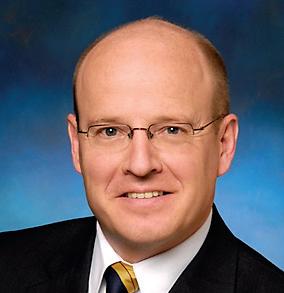
Further, McKeeby said: “The judgment did not say that Southwest had to exactly follow the language used by Judge Starr. ... Southwest’s notice complied with the spirit and wording of the court’s judgment.”
McKeeby declared that the notices “clearly convey the message that Southwest is not allowed to discriminate or retaliate based on religion, and will not do so in the future.”
Company Tactics Analyzed Mix, the NRTW president, further analyzed Southwest’s recent court filings.
In its retrial request motion, South-
west, in essence, is asking the judge to admit: “Yeah, everything you said about this case in your final judgment is not true,” Mix said, adding wryly, “Like that’s gonna happen.”
Filing such a motion is a common legal maneuver for losers of civil cases such as Carter’s, Mix said. Doing so “stops the clock from ticking” on the appeal deadline. That gives the losing side more time to prepare its appeal while also taking a long shot at securing a retrial, Mix said.
“It happens all the time; they just kind of throw the kitchen sink at it and say, ‘You know, we deserve a new trial,’” he said.
Southwest is entitled to choose that route. But, considering the airline’s recent operational challenges, Mix said: “It’s kind of interesting that Southwest Airlines wants to go ahead and bring this up again. ... They’ve had a pretty bad ‘media month,’ if you ask me.”
The airline’s meltdown was so extensive, it seems most people know someone who was affected. Mix said his daughter was among the thousands of stranded passengers.
Ironically, while his daughter was entangled in Southwest’s travel nightmare, Mix’s organization was grappling with the airline in Carter’s court case.
The airline seemingly needs to fortify its ranks and regain its footing after massive cancellations, Mix said. Yet, “they want to have another round of discussion about mistreating one of their employees about something that had nothing to do with the workplace,” he said.
Carter’s quarrel was with the union, not the company. If Southwest “would have just stayed out of it ... that would have been a whole different story,” Mix said.
Instead, the company took extra steps to connect Carter’s Facebook posts to Southwest, Mix said.
Charlene Carter won a $5.1 million verdict against Southwest and her union, but Southwest is asking the judge to find fault with his own rulings and grant a retrial in the U.S. District Court in Dallas.
Southwest dug through Carter’s Facebook photo albums to find years-old pictures of her in uniform. That was enough, the airline said, to make Carter appear to be representing the company when she ranted against abortion.

“They were supposed to let everyone else know at Southwest Airlines that they wouldn’t do this type of thing to anyone else. And yet they thumbed their nose at the judge in that case.”
Mark Mix, president, NRTWCLOCKWISE FROM TOP L: NATIONAL RIGHT TO WORK FOUNDATION, ROBYN BECK/ AFP/GETTY IMAGES, MICHAEL CIAGLO FOR THE EPOCH TIMES
In her termination notice, the company said: “Charlene, when you posted the graphic [abortion] videos and pictures on Facebook, you were identifiable as a Southwest Airlines employee.” Therefore, the airline said, Carter “represented our company in a manner that is disparaging to Southwest flight attendants as well as to all Southwest employees.”
That’s a stretch, Mix says.
Regardless of the past issues and the continuing court disputes, Mix hopes Carter can return to work and continue her career.
Whatever happens, NRTW “will continue to litigate and protect her rights in the workplace,” he said, adding, “The foundation has been supporting her throughout this five-year legal odyssey.”
Meanwhile, on Jan. 6, Southwest filed a response to NRTW’s contempt allegation.
The airline says Starr should deny that motion.
Southwest said its communications to Carter’s coworkers “are consistent with the requirements the court imposed.”
Based on other court cases, proving contempt of court requires “clear and convincing evidence” of a violation committed willfully or in bad faith, Southwest said.

NRTW lacks the necessary proof, Southwest said. The company argues that its actions have shown it “substantially complied with this court’s order and acted in good faith.”
Besides making the required notifications, Southwest has scheduled Carter
for training at the end of this month.
Southwest criticized NRTW for quibbling over the wording in the court-ordered notices.
“Carter complains about the phrase ‘does not discriminate,’ rather than ‘may not discriminate’ in the email notice. That complaint is unwarranted,” Southwest’s lawyers wrote.
Because the jury’s verdict and Starr’s judgment were attached to that email, it was clear that “Southwest was found to have violated Carter’s rights,” the airline said.
And, putting the cherry on top of a controversy that has revolved around free speech, Southwest asserts its right to freely express its opinions. The airline declared that “Carter’s theory of contempt violates Southwest’s First Amendment right to speech.”
The logo of the African National Congress from behind the fenced area reserved for the media at the National Recreation Center in Johannesburg on Dec. 15, 2022.
 BY MARCO LONGARI/AFP VIA GETTY IMAGES
PHOTO
BY MARCO LONGARI/AFP VIA GETTY IMAGES
PHOTO
 BY DARREN TAYLOR
BY DARREN TAYLOR
On a rainy Wednesday morning, with a gunmetal gray sky overhead, four men in their late 20s share a street corner with a dead cat in the township of Thokoza, east of Johannesburg. Smoke rises above them as they share homemade cigarettes filled with cheap tobacco.
“Smoking helps us forget our problems,” said David Ngobese, 32. “There are no jobs here; nothing to do.”
“No hope,” said his friend.
The shell of a community hall loomed nearby, burned almost to the ground during anti-government riots that erupted in several cities in South Africa in July 2021.
The men trudged across a park once filled with happy children; it’s home
now to rats, rubble, plastic bags, and other waste.
Ngobese told The Epoch Times he’d been searching for a job since he graduated from technical college eight years ago.
“I am an electrician; I do piece [odd]
jobs but it is not enough, even for food,” he said.
Ngobese is one of an estimated 11 million people below the age of 34 who should be formally employed in Africa’s most industrialized and technologically advanced economy but aren’t.
Sociologists and other experts often refer to this section of the population as a “ticking timebomb.”
It was largely jobless youth who drove the death and destruction that unfolded during post-apartheid South Africa’s worst-ever civil unrest 18 months ago.

Statistics South Africa, the government’s data collection agency, put the current unemployment rate at almost 35 percent, the highest in the world.
As unemployment, poverty, and associated crime soar, anger directed at the
Corruption and maladministration have paralyzed South Africa’s state-owned enterprises.
African National Congress (ANC)—in power since Nelson Mandela became the country’s first black president in 1994—is building.
Decades of apartheid created the most unequal society in the world, and decades of ANC governance haven’t changed that.
Most of the country’s wealth comes primarily from the mining of minerals—including gold and platinum—agriculture, and manufacturing, which remains in the hands of white capitalists, joined by a small group of ANC-linked black businesspeople enriched by the party’s policy of black economic empowerment.
Corruption and maladministration have paralyzed state-owned enterprises.
Railways, for example, no longer function. South African Airways, once the
pride of the continent’s skies, is nearing bankruptcy. The state power utility, Eskom, is no longer able to keep the lights on, and electricity outages of up to 12 hours a day are now common, costing the economy billions in lost production, and lives.
To rescue government companies from collapse, successive ANC administrations have borrowed billions of dollars from international lending agencies and global bond markets at exorbitant rates, adding to South Africa’s ever-growing debt burden.
In October 2022, that stood at $256 billion.
Across South Africa, areas governed by the ANC have become wastelands of violence and desperation, once-thriving towns visited by tourists disintegrating.

(Far Left–Above) People gather to protest for water and electricity services by closing off the M25 highway in Inanda, South Africa, on April 13, 2022.

(Left) Informal settlements in Khayelitsha, home to millions of people in mostly impoverished circumstances, in South Africa on Feb. 22, 2022.

Funds meant for poverty alleviation, development, and service delivery have disappeared into the pockets of ANC mayors and councilors.
Refuse rots in the streets, uncollected, stark evidence of the decay the ANC has brought into the lives of the vast majority of citizens.
“When you visit these places, you can’t believe you’re in South Africa. It’s more like being in [war-ravaged] Somalia,” professor Alex van den Heever, of the department of governance at Wits University in Johannesburg, told The Epoch Times.
Even ANC veterans, such as Mavuso Msimang, who once carried an AK-47 to fight apartheid forces, acknowledge the party has been a “great disappointment.”
“People are fed-up with their
Jacob Zuma (Above) as African National Congress leader and South Africa’s president in early 2018, he promised “swift action” against “criminals” inside his party and government. But only one, a close ally of Zuma, has so far been charged with financial crimes. Ramaphosa himself has been increasingly hamstrung by allegations of money laundering and tax evasion against him.

selfishness and lies, and their unfulfilled promises to change,” he told The Epoch Times. “The ANC stopped being the ANC I knew a long time ago. It is literally killing itself.”
Van den Heever said the party is being “torn apart” by factions battling to control lucrative government contracts.
In some provinces, ANC officials competing for seats on town and city councils, and by extension access to tenders and contracts, are murdering one another.
“The ANC members, because they’ve not been able to grow the GDP of the country, they’re fighting over a shrinking cake, and the fights are becoming
more bitter; murders are kicking in, political assassinations are kicking in,” Sandile Swana, an independent political analyst, told The Epoch Times.
“From here, it’s going to get worse, for as long as the ANC remains in power.”
When unionist-turned-mining-magnate Cyril Ramaphosa ousted Jacob Zuma as ANC leader and South Africa’s president in early 2018, he was praised for acknowledging the presence of “criminals” inside his party and government.
He promised “swift action” against them.
But only one, a close ally of Zuma, has so far been charged with financial crimes.
Ramaphosa himself is increasingly hamstrung by allegations of money laundering and tax evasion against him, related to the mysterious theft of at least $600,000 from his luxury game ranch in early 2020. The incident was exposed only late last year, by Zuma’s former police intelligence chief.

Yet Ramaphosa’s alleged crimes pale alongside those of his predecessor. A commission of inquiry has concluded that more than 500 billion rand ($34 billion) may have been stolen from stateowned entities during Zuma’s nine-year tenure, from 2009 to early 2018, mostly during the last four years of that period.
Some financial experts say the figure’s closer to $70 billion.
The commission linked several high-ranking ANC officials, including former and current Cabinet ministers, to the corruption that’s become known as “state capture” in South Africa.
Ramaphosa said his prosecutors were building cases against them, but not one has been indicted.
ANC veteran Pallo Jordan, one of Mandela’s first Cabinet ministers, told The Epoch Times his organization made a “good start” in government in 1994, after replacing the white National Party, which had been in power since 1948.
“We gave human rights to all. We built millions of houses and gave water and electricity to millions of poor people. Our job creation policies were working, we were bringing crime down.
“We made mistakes, but the progress continued under President [Thabo] Mbeki.”
Mbeki succeeded Mandela in 1999, but was ousted by Zuma in 2008.
“That’s when the rot started to set in,” Jordan said.
But another ANC veteran, and formerly the government’s top statistician, Pali Lehohla, told The Epoch Times the party’s “good start” lasted only two years.
“By 1996, there was dramatic change, and things changed for the better. The question is, did they change for the better sustainably? All those things have fallen apart! We don’t even have electricity anymore. Ukraine has more electricity than us!
“Yes, the ANC built houses, but many housing projects have been ruined by corruption and substandard building. The education and health systems, which started off so well, have been mismanaged to the point of ruin.
“People die every day because the state can’t provide them with medicines and proper care. Services have collapsed in almost every ANC municipality.”
Lehohla said he was “sick” of the ANC blaming Zuma and his allies for “everything that’s wrong” with South Africa today.
“It hurts to say but even under Madiba [Mandela’s clan name], there were signs that the ANC was abandoning its mission to improve the lives of the poor. People forget there was corruption under Madiba and Mbeki as well,” he said.
The first major corruption scandal involving the ANC happened a few months after Mandela took office. His delegate to the United Nations, Rev. Allan Boesak, was accused of “misusing” funds donated to a “peace and justice” group with ties to the ANC.
The ANC is being ‘torn apart’ by factions battling to control lucrative government contracts, an expert says.
An internal party investigation, led by Mbeki, cleared Boesak of wrongdoing, a finding that the Scandinavian donors described as “ludicrous.”
Soon after, local media reports implicated Mandela’s health minister, Dr. Nkosazana Zuma, in fraud. She allegedly “misappropriated” millions of rand meant to fund a play called “Sarafina,” that warned youngsters against unsafe sex.
Mandela accused the media of “creating an uproar,” saying Zuma should be “left alone to do her job.”
And that’s exactly what the ANC and its law enforcement agencies did, establishing a modus operandi that continues to this day.
In October 1996, more than a year after the minister’s alleged corruption had been exposed, professor Steven Friedman, then of the Centre for Policy Studies in Johannesburg, told The New York Times: “The ANC has established a very clear pattern and the pattern is simple: You can be whatever you like as long as you are loyal.
“The minister of health may be responsible for ‘Sarafina’ but she is loyal, so she will be defended. The problem is you can’t deal with corruption this way.’’
The same article quoted Ramaphosa, then the ANC’s third-in-command, as saying: “The ANC is pained immensely by stories of corruption. We are highly conscious of the damage that corruption does to a party and a country.”
Themba Sono, frequently jailed by the apartheid government for activism that stretched over three decades, grew up supporting the ANC. It would later expel him for “indiscipline.”
Sono, now an 81-year-old retired economist, told The Epoch Times, “I saw the signs early on and they got rid of me and my big mouth.
“I warned that we were replacing a corrupt white government with a corrupt black government.
“But no one wanted to hear the truth; they just wanted to hear about the ‘miracle’ of the ‘new’ South Africa.
“Mandela and I were friends, but he was often blind to the failings of the people around him.”

Ever since it came to power, the ANC has “protected, nurtured and promot-
ed” the corrupt in its ranks, to the extent that the party “now resembles an organized crime syndicate,” Swana said.
Nkosazana Zuma has been in various positions in the Cabinet ever since the “Sarafina” episode and has been implicated in numerous cases of corruption. She recently ran an unsuccessful campaign to replace Ramaphosa as ANC leader.
Her ex-husband, Jacob Zuma, became president in 2009, despite strong evidence he’d siphoned off millions of rand from a multibillion-dollar deal signed in 1999 to “modernize” South Africa’s armed forces with new aircraft, warships, and weapons.
The ANC protected Zuma, and other leading party figures, including Mbeki,
from allegations of fraud, corruption, bribery, racketeering, and money laundering connected to the arms deal.
Charges were reinstated against Zuma after he lost the presidency; he’s currently fighting to have them dismissed.
“The ANC has always had a policy of cadre deployment,” Van den Heever said. “In terms of that, instead of giving top jobs to people based on skill and merit, it rewards loyal members with those jobs. Its argument has always been, ‘If we put loyal ANC members in those posts, they will implement our policies and everything will be okay.’
“But, of course, policies are useless when you don’t have the skill and experience to implement them.
“So now we sit with state enterprises
and national, local, and provincial governments packed with unqualified people whose priority is the ANC, and in many cases, stealing on behalf of the ANC.”
But it isn’t the ANC’s “obvious” corruption that will ultimately “destroy” it, Swana said.
“A government can steal as much as it wants, as long as it leaves enough behind for its people,” he said. “If citizens have jobs, food, shelter, basic services, safety and security, education for their kids ... Well, a government can get away with pretty much anything.”
What’s eventually going to result in the ANC losing power, Swana said, is its failure for the past 30 years to implement a credible economic strategy, that would spark consistent growth to pull significant numbers of citizens out of poverty.

“Business has been presenting plans to government for years about how the economy should be rebuilt, but the ANC doesn’t hear sense,” he said. “It says it wants to involve all sectors in developing the country. But really it wants to control every aspect of society that involves money.”
Oscar van Heerden, a political economist at the University of Fort Hare, told The Epoch Times that the ANC had failed because of its “inherent corruption and immorality,” but also because it had always lacked the courage to take “tough decisions.”
Primarily, he said, the government should have privatized state-owned industries.
“Private companies are motivated by profit. This incentivizes them to be more productive and more efficient and to deliver better services. They could raise more money for government.”
But privatization is anathema to the ANC’s communist partners and, perhaps more significantly, to the labor unions that traditionally campaign for the ANC ahead of elections.
Van Heerden said privatization would also “crush” the criminal syndicates “bleeding” public corporations.
But, Van den Heever said, this
tions, in so doing making ... sure that struggle, poverty, and lack of development will be entrenched in South Africa for generations to come.”
The ANC overperformed at the polls in 2019, according to political analysts, garnering more than 57 percent of the vote.
Pali Lehohla, former statistician, ANC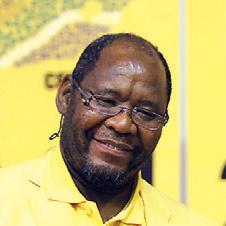
“People voted ANC four years ago because they saw Ramaphosa as a messiah; they believed his message of change and renewal following the utter devastation of the Zuma years,” Lehohla said. “That optimism faded very fast.”
Swana said the local government elec-
wouldn’t be in line with the ANC’s “selfish interests” and “dedication to state control.”
“I’m not saying there’s no corruption in the private sector. The Jacob Zuma administration collaborated closely with local and international private firms to plunder the public purse,” he said. “But privatization of state assets, such as Eskom, would undoubtedly stem the flow of illicit money that’s currently keeping the ANC on life support.”
Van Heerden said the ANC was also “too scared” to end food subsidies, which had distorted markets and “stunted” diversification of the economy, and to deregulate markets to encourage competition.
“The ANC doesn’t want competition; it wants control of a limited number of players,” Van den Heever said.
“Only a few countries in the world can afford such a luxurious policy and we aren’t one of them. Yet we have it because the ANC wants young votes.”
He said the ANC had failed South Africa largely because it continued to “bow and bend to the most ridiculous demands” from public-sector unions.
“The government knows that tens of thousands of workers are surplus to requirements across the state sector. It knows that some of its ministers are useless and that some are worse; they’re criminals. But it does nothing to free South Africa of these burdens.
“Instead, what does it do? It takes out huge loans, indebting future genera-
A volunteer cooks porridge for children in an underprivileged area in Johannesburg on May 23, 2020.
“Services have collapsed in almost every ANC municipality.”
tions of 2021 represented a more accurate reflection of the ANC’s decline. It got less than 48 percent of the national vote, the first time in its history as the governing party that it failed to secure more than 50 percent.
The ANC lost control of several major cities and towns.
A poll by the international market research group Ipsos was one of many that emerged last year to find that the party likely would’t get enough of the vote in 2024 to win outright control of government.
To hold on to significant power, the ANC would have to enter a governing coalition.
The chief opposition party, the broadly centrist Democratic Alliance, with almost 21 percent of the vote in 2019, has rejected the possibility of cooperating “in any way” with the ANC.
Its most likely bedfellow, Van den Heever said, would be the country’s third-largest party, the Economic Freedom Fighters (EFF), which won almost 11 percent of the vote four years ago.
The EFF, led by its firebrand, ultra-leftist, corruption-accused “commander-in-chief,” Julius Malema, has said for it to consider any “alliance” with the ANC, the ruling party would have to agree to its “non-negotiable” demands.

These include the nationalization of “all forms of wealth,” including mines and financial institutions; expropriation of land and property owned by whites, without compensating them; and the “destruction of white monopoly capital.”
Malema told The Epoch Times: “When these things happen, wealth will pass into the hands of the rightful owners of South Africa, the black majority. The whites who want to stay in the country are welcome, but opportunities will be much more limited for them.
“Up to now, the ANC has partnered with white capitalists simply to build a small black elite, while most black people get poorer. We will make sure this changes when we are in government. Pro-poor policies are the answer, not pro-business.”
There is, of course, the possibility that the ANC corrupts the Independent Electoral Commission ahead of the 2024 polls, to rig the election to ensure it gets the majority it needs to maintain absolute power.
It’s a scenario that even its fiercest critics agree is unlikely.
“The ANC, as corrupt and incompetent as it is, prizes the fact that South Africa’s seen as one of the few strong democracies in Africa. It cannot be denied that every election since 1994 has been free and fair.
“The ANC also prizes its membership in the G-20. It’s not going to jeopardize this by rigging an election when there are still other options open to it to continue having a strong hand on the levers of power,” Van den Heever said.

In 2004, Jacob Zuma declared that the ANC “would rule South Africa until Jesus comes back.”
In 2023, his prediction faces its greatest test.
“Up to now, the ANC has partnered with white capitalists simply to build a small black elite, while most black people get poorer.”
Julius Malema, leader, Economic Freedom Fighters

PEOPLE WATCH SEAGULLS FLY BY while sitting on the banks of the Ganges River during the annual Magh Mela festival at the Triveni Sangam, the confluence of the Ganga, Yamuna, and Saraswati rivers, in Prayagraj, India, on Jan. 14.
 BY SANJAY KANOJIA/AFP VIA GETTY IMAGES
PHOTO
BY SANJAY KANOJIA/AFP VIA GETTY IMAGES
PHOTO
Doctors told California man with heart condition that cross-sex hormones were killing him
BY BRAD JONESman born W ith a heart defect says taking estrogen and testosterone-blocker pills in a desire to become female almost killed him.
David Bacon of Monterey County, California, was told by his doctors in 2017 that he had two weeks to live if he didn’t quit the cross-sex hormones he started taking in 2014, he said.
“Hormone replacement therapy almost killed me,” Bacon, now 31, told The Epoch Times. “My experience was very traumatic and life-threatening.”
Before he was prescribed the drugs, Bacon said two therapists advised him that he could be at risk of suicide if he didn’t transition his gender.
Bacon suffers from pulmonary atresia, a birth defect of the heart in which the valve that controls blood flow from the heart to the lungs doesn’t form, making it difficult for blood to flow to the lungs to pick up and carry oxygen to the body.
David Bacon, who went by Lisa while taking estrogen, at 25 years old.

“Something didn’t feel right with my body. Something felt off. I didn’t know it at the time, but it was just puberty.”
 David Bacon
David Bacon
(From Top) David Bacon at 5 years old, 6 years old, and 9 years old, in Seaside, Calif.


He has had nine open-heart surgeries to implant heart valves made of bovine and porcine animal tissue, which become clogged or wear out over time.
Early in his childhood, Bacon developed post-traumatic stress disorder (PTSD) from the surgeries. When he was 13, he woke up in the middle of an operation, which only compounded his fear and anxiety, he said.
“It was very traumatic. I already had PTSD, so that just added more to it,” he said. “I’m one of the very few people who can say ‘I’ve seen the inside of my heart.’”
At school, his medical condition kept him from doing strenuous activities and playing certain sports. He was homeschooled until fifth grade and given an Individualized Education Plan for children with disabilities when he entered public school.

“I had a learning curve,” he said. “My attention span wasn’t there all the time.”
Bacon said his mom always suspected he might have some form of autism or ADHD, but he was never tested for it.
In fifth grade, Bacon began attending public school.
He recalls coming home from school one day feeling out of sorts with his gender. That evening, Bacon wanted to tell his family but couldn’t find the courage.
His mom knew something was wrong.
“I told her I didn’t want to be a boy,” Bacon said. “Her face literally had this shock.”
Then he asked her to take him to the doctor to get puberty blockers.
“Her jaw dropped to the floor,” he said.
Bacon remembers that his mom prayed a lot, went to church, read her Bible, and sought counseling. She didn’t encourage his gender transition.
“She just thought it was a phase,” Bacon said.
At about 12, Bacon became even more confused about his sexual orientation.
“Something didn’t feel right with my body. Something felt off. I didn’t know it at the time, but it was just puberty,” he said.
Some boys in middle school bullied him and called him gay for chumming around with girls and a male friend who ended up being gay.
“I got beat up,” he said. “I vividly remember middle school. It was terrible.”
The bullying continued throughout high school, Bacon said. It affected his ability to focus on schoolwork. His grade point average was so
low in his senior year that he dropped out, opting for a home study program. He graduated in 2009.
“My GPA skyrocketed, so the bullying was a problem for me,” he said.‘I Wanted to Be Female’
Bacon identified as “queer,” but as time went on, he began dressing in more feminine clothes, and by the time he was 18, he was committed to the idea of a full gender transition.
“I really felt like I was actually a female. I did fully feel that I was a woman,” he said.
He began taking estrogen and testosterone blockers in November 2014. He was 23.
About a year and a half into hormone replacement therapy, Bacon went to the Planned Parenthood office in Salinas, California, to meet with a surgical team of gender transition specialists.
“I apparently met their requirements for breast implants and bottom surgery,” he said.
He compared the Planned Parenthood experience to “a Build-a-Bear workshop” where he was expected to create a female version of himself, he said.
“They had about 40 different breast types and sizes to select,” he said. “It was very weird.”
The specialists also discussed bottom surgery. “They were also talking about removing my penis,” he said. “They call it penis inversion. ... They showed me 27 pictures of what my vagina could look like.”
But when the specialists left the room, a nurse gave him more details about the surgeries. She told him more than 90 percent of male-to-female transgender patients usually kept their male genitals, and that surgically created “vaginas” made from penis inversions, or vaginoplasty, weren’t without medical complications.
“They have this process called dilating, where you have to put something up there four to five times a day to keep it from closing because it’s literally just an open wound,” Bacon said.
After that discussion, Bacon decided against any surgeries—top or bottom.
In 2015, Bacon legally changed his first name and attended Monterey Peninsula College as Lisa Bacon.
However, with his medical problems and pre-
occupation with gender, he lost focus in college and dropped out.
Bacon began “hooking up” with men he met on gay dating sites while living as a woman, an experience he deeply regrets.
“I looked like a female head to toe. I had long hair too. ... I played the part,” he said.
But when Bacon turned 25, he began to have doubts about transitioning.
“I started to realize something was off. Something didn’t seem right,” he said.
His parents suggested he get a third opinion from a private psychologist, so he called his health insurance provider for referrals.
“The psychologist helped me discover who I am,” he said.
Throughout the talk therapy sessions, he wondered whether transitioning was the right choice for him. The therapist also suggested he might be autistic.
When he was 27, Bacon’s health took a turn for the worse, and he went to the University of California–San Francisco cardiology department for tests.
The results were devastating. The doctors told him he would die unless he stopped taking hormone-replacement drugs immediately.
old while taking estrogen.

“The psychiatrists are the ones pushing gender ideology and prescriptions. The psychologist helped me discover who I am.”
David Bacon
A poster at an RSU 22 school in Maine suggests coming up with a new gender.

“I was living as a woman right up until the doctors told me I had two weeks to live,” he said. “I chose life.”
The withdrawal from estrogen was like going through puberty again, he said.
“I had bone aches,” he said. “I had muscle density increasing because my testosterone was increased, so I literally went through puberty again as an adult and it was twice as bad.”
Although Bacon has many regrets about his past, he doesn’t dwell on it. He threw out every piece of women’s clothing he had.
“I got it out of my house so I wouldn’t be attracted to it anymore. It was a life-changing decision, and it was for the better,” he said.
To Bacon, transgender theory is exactly that: a theory.
“A male cannot turn himself into a female and have a baby. That’s what it boils down to in my eyes, and a female cannot truly become a male,” he said.
Looking back, Bacon said, it’s concerning to him he even knew about puberty blockers as a boy.
“I was duped as a kid,” he said. “I don’t even know why I fell for it. I literally fell for it. Every-
thing that I took, I was an adult. I made the decision as an adult, and I feel stupid for it. But, you know, we all make mistakes. We’re only human.”
Bacon now calls himself “ex-transgender” and urges more men like himself to step forward.
“It takes courage to do this,” he said. “Men are afraid to speak out.”
Bacon is disappointed some activists in the LGBT community have dismissed the voices of detransitioners.
“I felt like I was being indoctrinated in a way, ostracized from certain groups after I left, and then dehumanized,” he said. “It’s heartbreaking, all this stuff that they throw at us.”
Bacon urges more tolerance and respect on all sides of the transgender debate.
“It doesn’t mean that I agree with their ideology. It just means that I’m respecting them as human beings. We need to start treating each other with more respect,” he said.
Bacon still suffers from social anxiety and feels “a little agitated and irritated” in large groups of people.
“It’s not them. It’s just me,” he said.
But lately, Bacon has been producing a podcast called The Bacon Project—and the experience,
Aside from estrogen harming David Bacon’s heart, the testosterone blocker also shrunk his testicles to the point that he thinks he might be sterile.
he said, has been therapeutic.
Today, he has a small circle of friends—some who knew him before he transitioned—who accept him for who he is. Bacon said he is also ready to date women as the man he always was.
“I’m straight as an arrow,” he said of his sexual orientation.
He has changed his legal name back to David and reverted his driver’s license and other identification back to his birth name. Bacon also has been taking online courses to prepare himself for his eventual return to community college.
“I honestly thought I was brain-dead half the time when I was going to college because I was on medications. It was brain fog most of the time,” he said.
But, since quitting hormone replacement drugs, Bacon feels clear-headed.
He now exercises to feel better and reshape his body to look more masculine. He has grown some facial hair and has taken supplements to boost his testosterone levels.
Recovering from the transgender experience
has left Bacon with a fresh outlook on life and a renewed interest in his Christian faith.
“Guardian angels have been protecting me my entire life. I truly believe that,” he said. “I believe in God. There is an order to the universe. That’s why we have male and female when it comes to animals and humans. I believe in the natural order of things.”
Bacon ran unsuccessfully for a seat on the Monterey Peninsula Unified School District Board of Education in November.
During his campaign, he discovered the school district approved a resolution calling for the recognition of June as LGBTQ Pride Month at the pre-kindergarten level.

“When I saw that, I was like, ‘No, no, no—not an elementary school, not a middle school,’” he said.
While some argue there may be a case for LGBT awareness in high school, Bacon disagrees.
“I still wholeheartedly believe it shouldn’t be in high school, but there’s an argument to be made and I understand that. ... I’d say no, until you’re an adult until you’re 18,” he said.
David Bacon believes that the ‘subliminal messaging’ of the ‘Be Kind’ sign at school planted the seed for his gender confusion.
Several tranches of classified documents have been found from Biden’s time as vice president

 BY TOM OZIMEK
President Joe Biden arrives to deliver remarks in the Eisenhower Executive Office Building in Washington on Jan. 12.
PHOTO BY KEVIN DIETSCH/GETTY IMAGES
BY TOM OZIMEK
President Joe Biden arrives to deliver remarks in the Eisenhower Executive Office Building in Washington on Jan. 12.
PHOTO BY KEVIN DIETSCH/GETTY IMAGES
FROM A CLOSET at the Penn Biden Center to a garage where the president keeps his classic Corvette, the discovery of sensitive materials has sparked public interest and drawn legal scrutiny.
U.S. Attorney General Merrick Garland has appointed a special counsel to investigate the case, while Republicans have alleged a two-tier justice system in which former President Donald Trump— who faces his own classified document probe—is seen as being treated more harshly, while Biden is supposedly being treated with kid gloves.
The White House is facing growing criticism for not disclosing the initial find of the Biden-linked documents until two months after their discovery on Nov. 2, 2022—a week before the midterm elections—and even then, the Biden administration only publicly acknowledged the existence of the materials after media outlets broke the story.
House Republicans are demanding answers, opening an investigation, and pointing to a link between the address where the second batch of classified documents was found and the president’s son, Hunter Biden, who’s under federal investigation for various financial and business dealings.
Below is a timeline of the disclosures and discoveries regarding Biden’s classified documents and where things could go from here.
Biden started working at the Penn Biden Center for Diplomacy and Global Engagement at the University of Pennsylvania in February 2017, after leaving office as vice president under the Obama administration.
He served as a professor at the think tank, which has a stated goal of fostering a deeper understanding of U.S. foreign policy and developing new ideas for advancing U.S. diplomatic and global leadership.
There have been concerns about possible links between the center and the Chinese Communist Party (CCP). The University of Pennsylvania, which houses the Biden Penn
Center, received more than $54 million between 2014 and 2019 in anonymous donations from China, according to the New York Post, citing public records.

A university spokesperson denied that any money from China was funneled to the center.
“The Penn Biden Center has never solicited or received any gifts from any Chinese or other foreign entity. In fact, the University has never solicited any gifts for the Center,” spokesperson Stephen MacCarthy told the NY Post.
Biden stopped working at the center at about the time he became president.
President Joe Biden said he was “surprised” when classified documents were found in his former office at a Washington think tank and portrayed it as an honest mistake. However, since other batches have been found at his Delaware residence, pressure has been mounting for an explanation of what’s fast becoming a crisis of credibility for the White House.
Nov. 2
According to Richard Sauber, special counsel to the president, attorneys representing Biden found a “small number” of records with classified markings inside a locked closet at the think tank office— roughly 10 documents—and notified the National Archives and Records Administration (NARA) of the discovery in short order.

Nov. 3
Biden’s lawyers transferred the documents to NARA for secure storage one day after their discovery, Sauber said in a Jan. 9 statement, noting that the president’s attorneys were cooperating with NARA and the Department of Justice (DOJ).
The Office of the Inspector General at the National Archives reached out to a prosecutor at the Department of Justice on Nov. 4 to notify them of the discovered documents, according to a Jan. 12 statement by Garland.
“That office was not authorized for storage of classified documents,” Garland said, noting that the prosecutor was informed that day that the materials had been secured at a National Archives facility.
In line with standard procedures, the FBI began an assessment to determine whether any mishandling of classified information occurred in violation of federal laws, according to Garland’s Jan. 12 statement.
Garland assigned John Lausch, the U.S. attorney for the Northern District of Illinois, to conduct an investigation

and decide if it was necessary to appoint a special counsel to probe the circumstances around the handling of the sensitive materials.
“I selected him to conduct the initial investigation because I was confident his experience would ensure that it would be done professionally and expeditiously,” Garland said on Jan. 12.
Biden’s personal attorneys notified Lausch that more documents with classified markings were discovered in the garage at the president’s Wilmington home. They were among other records from Biden’s time as vice president.

The FBI then went to Biden’s home to secure the documents, according to Garland’s Jan. 12 announcement.
The FBI began an assessment of the classified information on Nov. 9, 2022.
The Department of Justice was notified of the discovered documents on Nov. 4, 2022.

Republicans said that they had obtained documents showing that Biden’s Wilmington home address was listed on his son Hunter’s driver’s license.
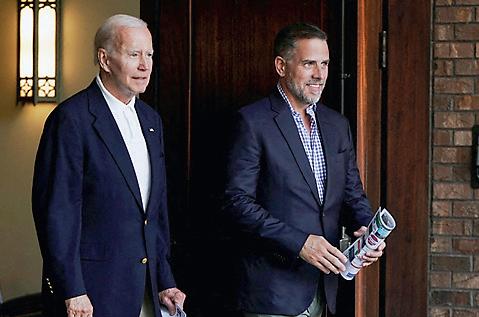
Republicans said in a letter to White House counsel Stuart Delery on Jan. 13 that they had obtained documents showing that Biden’s Wilmington home address was listed on his son Hunter’s driver’s license as recently as 2018, suggesting that he could have had access to the documents.
Links between the tranche of documents and Hunter Biden are notable, as Republicans have long sought to investigate connections between the president and his son’s controversial business ventures in China and Ukraine. Before Republicans took control of the House, they announced that they wanted to make investigating the Bidens’ business dealings a priority.
Biden, in a Jan. 12 exchange with Fox News reporter Peter Doocy, confirmed that the documents were stored “in a locked garage” next to his classic Corvette.
“But as I said earlier this week, people know I take classified documents
and classified material seriously,” Biden said, noting that his team is cooperating “fully and completely” with the DOJ probe.
2023
Jan. 5
Lausch updated Garland with the findings of his preliminary inquiry and suggested the need for a special counsel to continue the investigation.
Garland decided, following Lausch’s report, that appointing a special counsel was necessary for the public interest, as per the regulations for a special counsel.
Jan. 9
For the first time since the discovery of the documents, the White House disclosed publicly that sensitive materials had been found at Biden’s temporary office at Penn Biden Center and stated that it’s cooperating with investigators.
“The documents were not the subject of any previous
Republicans said they expect that President Joe Biden will face the same kind of treatment for storing classified materials in an unsecure location as did former President Donald Trump, whose Florida home was raided by the FBI.
John Lausch, the U.S. attorney for the Northern District of Illinois, on Jan. 5 suggested the need for a special counsel to continue the investigation.

request or inquiry by the Archives,” Sauber said in a statement. “Since that discovery, the president’s personal attorneys have cooperated with the Archives and the Department of Justice in a process to ensure that any Obama–Biden Administration records are appropriately in the possession of the Archives.”
Republicans reacted by saying they expected that Biden will face the same kind of treatment for storing classified materials in an unsecure location as Trump, whose Florida home was raided by the FBI in August 2022.

“When is the FBI going to raid the many homes of Joe Biden, perhaps even the White House?” Trump commented on his Truth Social platform. “These documents were definitely not declassified.”
Lawyers for the DOJ have alleged that Trump could have violated several laws by keeping the documents, including the Espionage Act.
Trump has insisted that he declassified the documents in line with presidential powers.
No charges have been brought against Trump over the materials.
Jan. 10
Biden said during a visit to Mexico that he was “surprised” to learn that classified documents had been found at the Penn Biden Center. The president said he wasn’t aware of what the materials contained and that his lawyers have suggested he not ask what was in the documents.

Rep. James Comer (R-Ky.), the new chair of the House Oversight Committee, said the panel has already opened a probe into Biden’s handling of sensitive materials.
“The Committee is concerned that President Biden has compromised sources and methods with his own mishandling of classified documents,” Comer wrote in a letter to Delery, while pointing out that Biden has previously called the mishandling of presidential records “totally irresponsible.”
On the same day, Comer also wrote a letter to NARA Acting Archivist Debra Steidel Wall to raise the question of “political bias” at the agency over what he described as “inconsistent treatment of recovering classified records” held by Biden and Trump.
The National Archives confirmed receipt of the letter in a statement to The Epoch Times but provided no further comment.
Lawyers working for Biden finished searching his homes in Wilmington and Rehoboth Beach for additional official documents that may have been taken there during the transition between the Obama and Trump administrations in 2017, according to a Jan. 12 statement by Sauber.
The president’s personal
Republicans demanded that the DOJ take a tougher line on President Joe Biden, alleging bias against the GOP at the nation’s investigative agencies and judicial system.
attorneys found a one-page document with classified markings stored in a room adjacent to the garage at Biden’s Wilmington home, and since they lacked security clearances, they halted the search, Sauber would reveal on Jan. 14.
White House press secretary Karine Jean-Pierre delivered the first press briefing since news of the documents became public on Jan. 9. She defended the administration’s actions while declining to answer how the documents came to be at the office.

Republicans demanded that the DOJ take a tougher line on Biden, alleging bias against the GOP at the nation’s investigative agencies and judicial system.
Biden’s personal attorneys notify Lausch that an additional classified document was found at the president’s Wilmington home, according to Garland’s announcement.
White House press secretary Karine Jean-Pierre on Jan. 9 declined to answer how the documents came to be at Biden’s Wilmington home.
Sauber, who has security clearances, and several DOJ officials went to Biden’s Wilmington home to pick up the search where the president’s personal attorneys left off the prior day, and they found an additional five pages of classified documents, he said on Jan. 14.
No additional documents were found at Biden’s residence in Rehoboth Beach, he said.
Garland announced the appointment of Robert Hur, the former Trump-era U.S. attorney for the District of Maryland, as special counsel to investigate the handling of the Biden-linked documents.
“This appointment underscores for the public the Department’s commitment to both independence and

accountability in particularly sensitive matters, and to making decisions indisputably guided only by the facts and the law,” Garland said.
Sauber said the White House would cooperate with Hur’s probe.
House Republicans reacted to the appointment of the special counsel by saying that they would press ahead with their own investigation.
“With or without a special counsel, the House Oversight and Accountability Committee will investigate President Biden’s mishandling of classified documents and the Swamp’s efforts to hide this information from the American people,” Comer said in a statement.
Comer said the National Archives, the DOJ, and the White House were all aware of the Penn Biden Center document stash before the midterm elections but chose not to disclose that publicly.
“There are many questions about why the Biden Administration kept this matter a secret from the public, who had access to the office and the residence, and what information is contained in these classified documents,” Comer said.
“Republicans will push for transparency, accountability, and answers for the American people.”
Jan. 14
The public learned of the discovery of the additional batch of classified documents found at Biden’s Wilmington home as Sauber issued a statement detailing the find from days earlier.
“Five additional pages with classification markings were discovered among the material with it, for a total of six pages. The DOJ officials with me immediately took
possession of them,” Sauber said, noting that the White House would cooperate with the special counsel probe.
Bob Bauer, the president’s personal attorney, issued a statement saying that Biden has directed his personal attorneys to be “forthcoming and fully cooperative” with the investigation.
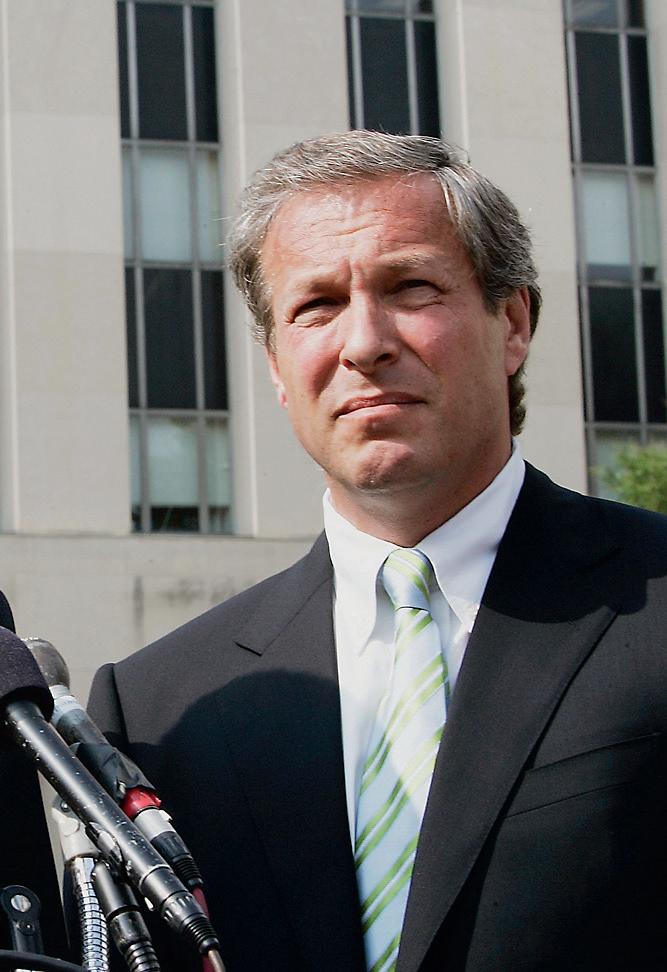
Richard Sauber, special counsel to President Joe Biden, said the White House would cooperate with Robert Hur’s probe.
A teleprompter displays Attorney General Merrick Garland’s remarks announcing the appointment of Hur as special counsel to investigate the handling of the Biden-linked documents.

House Republicans reacted to the appointment of the special counsel by saying that they will press ahead with their own investigation.CLOCKWISE FROM TOP L: ALEX WONG/GETTY IMAGES, JOSHUA ROBERTS/REUTERS, TASOS KATOPODIS/GETTY IMAGES, CHIP SOMODEVILLA/GETTY IMAGES
Jan. 15
In response to the latest document find, Republicans requested visitor logs for Biden’s Wilmington residence dating from the president’s inauguration to the present.
“President Biden’s mishandling of classified materials raises the issue of whether he has jeopardized our national security,” Comer stated in a letter to White House chief of staff Ron Klain. “Without a list of individuals who have visited his residence, the American people will never know who had access to these highly sensitive documents.”
Comer also demanded that the White House provide documents and communications about all locations searched, as well as the identities of the Biden aides involved in the searches.
Jan. 16
The White House announced that there are no logs of who has visited Biden’s Wilmington home. The U.S. Secret Service, which provides security for the president, told The Epoch Times that
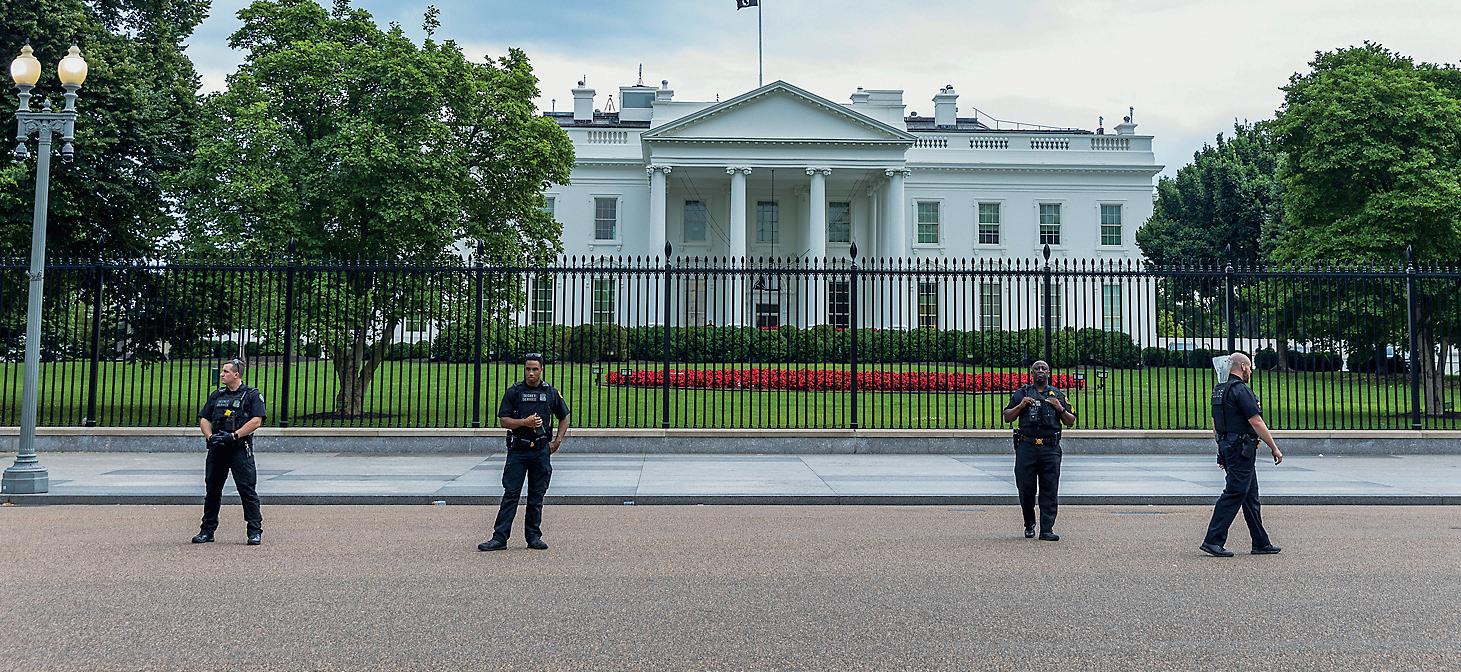

The White House has announced that there are no logs of who has visited Biden’s Wilmington home.
Jan. 15, 2023.
it screens visitors to Biden’s residence but doesn’t keep records of who’s vetted.
Republicans criticized the lack of documentation and accused the White House of obfuscation.
Comer told The Epoch Times in an emailed statement that Biden “promised to have the most transparent administration in history, but he refuses to be transparent when it matters most.”
He said Republicans will continue to press the Biden administration for answers.
The White House, in turn, criticized Republican investigations into Biden’s handling of classified documents.
White House spokesman Ian Sams told media outlets in a statement that Biden is “doing the right thing and is cooperating fully with a thorough review” while accusing Republicans of “playing politics in a shamelessly hypocritical attempt to attack” their political opponent.
The total number of Bidenlinked classified documents that have been found remains unclear.
Both the special counsel’s investigation and the Republican probes into the matter continue.
Zachary Stieber contributed to this report.
America’s electric grid could be driven toward instability amid net-zero agenda
BY KEVIN STOCKLINGovernment policies are pushing ever more Americans onto the U.S. electric grid even as the climate-change experiment makes the grid increasingly unstable.
In August, Massachusetts joined California, New York, and Washington in passing laws to restrict the use of oil and gas in new home construction. Several states have also set dates for banning the sale of gasoline-powered cars.
At the federal level, the electrification effort has included heavy subsidies for electric vehicles (EVs) and charging stations, even a contemplated ban on gas stoves. On top of government efforts comes the environmental, social, and governance (ESG) movement, which has succeeded in arm-twisting corporations and public utilities into compliance with its net-zero emissions agenda.
All of this makes Americans more dependent on the electric grid at a time when utilities are accelerating the closure of coal and gas-fired plants, leaving the grid increasingly reliant on intermittent wind and solar power. This has sparked warnings from utility infrastructure experts that America’s dash toward renewables could be driving our electric grid toward instability.
“Running while we’re tying our shoes is the analogy I would give,” John Moura, director of reliability assessment at the North American Electricity Reliability Corp. (NERC), told The Epoch Times. The NERC is charged with regulating electric utilities to ensure that they can deliver electricity whenever it is needed.
The NERC produces an annual long-term reliability assessment (LTRA). According to the 2022 LTRA, while many areas of the grid are expected to meet demand, several areas are at
“high risk” of falling short. Two high-risk areas are California and a mid-continent zone running from Ontario down through the Great Lakes region to Louisiana.
“The projected shortfall continues an accelerating trend ... as older coal, nuclear, and natural gas generation exit the system faster than replacement resources are connecting,” the LTRA states. In addition to the high-risk areas, areas of “elevated risk” included New England and the entire western United States outside of California.
A report by industry experts Paul Bonifas and Tim Considine, titled “The Limits to Green Energy,” puts it more bluntly:
“It is unknown what level of VRE [variable renewable energy] can be added to the grid before it breaks or becomes unaffordable. However, it is all but certain that at some unknown point, the grid will become unreliable and costs will skyrocket. And yet, more VREs are built every year.
“Is a 100 percent renewable grid technology possible, is it reliable, and is it economical? No, no, and no.”
The report states that the incessant shutting down of reliable power sources—gas, coal, and nuclear—will be destabilizing, and the costs to conform the grid to weather-dependent renewable power generation are “significant and unknown.”
Many of the issues stem from the physics of electricity and the architecture of our power grid, which Moura calls “the largest machine in the world.” America’s electric grid features hundreds of power plants situated throughout the United States connected to transformers that convert that power so it can be transmitted throughout the about 700,000-mile network of high-voltage transmission lines. The electricity then makes its way to neighborhood transformers
that
The United States is moving in the direction of having renewables be the dominant source of its electricity without having assessed the cost of necessary grid upgrades, or at what point this transition pushes the grid to its breaking point.

progressively step down the voltage so that it can be safely used in homes.
Because the electricity on the grid can’t sit idle or be stored for long periods, it must be consumed as it is created. Con versely, at the moment that people turn on the heat, charge a car, or flip a light switch in their homes, that electricity must be generated at the moment at some point along the grid.
“Electricity consumption and generation must always be balanced,” Bonifas and Considine write. “If it isn’t, the power grid could collapse. Thankfully, the immense size and interconnectedness of electricity grids make the balance issue easier to handle; billions of electrical loads across the country are constantly being added and removed, averaging out at any given moment.”
Under normal conditions, the LTRA report states, the North American grid has performed reliably. Because of the grid’s enormous size, a shortage of electricity in one area when demand is peaking can be covered by shifting excess supply from other areas; however, the grid has increasingly been struggling to do this in recent years, leading to outages on very hot or cold days, when people need electricity the most.
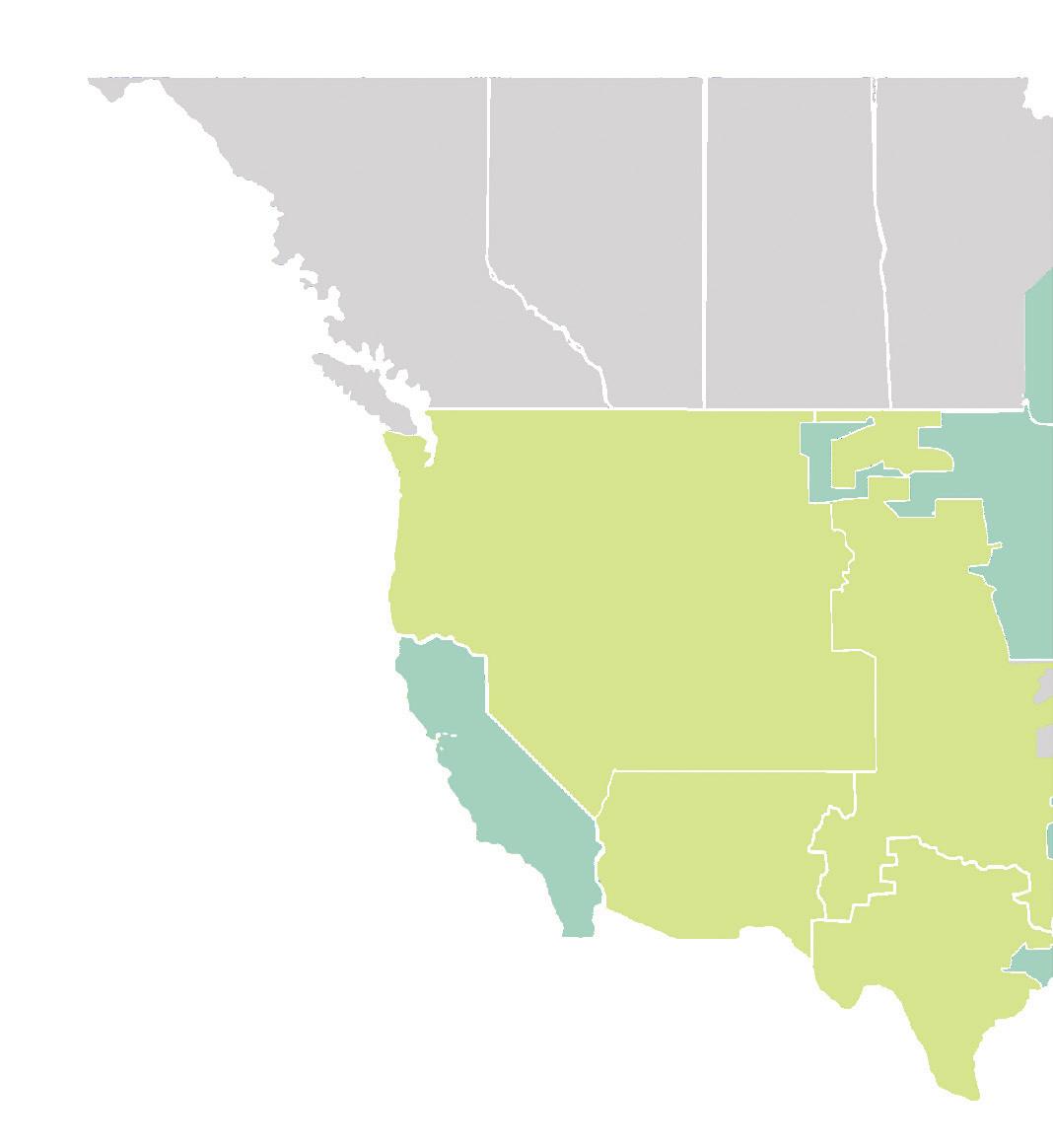
The problem comes when weather-dependent sources such as wind and solar are introduced into the grid at increasing rates. The problem is not just that VREs only generate power when the weather cooperates, but also that even when the weather is cooperating, the timing is off. For example, peak solar generation typically occurs about five hours before peak demand during the daytime, and peak wind generation often comes at night when demand is lower. And there are also seasonal mismatches between supply and demand for renewables.
“In the winter, one of the particular challenges with solar is that peak electricity demand is happening usually when the sun is down, early morning, or early evening,” Moura said. “You can add as much solar as you want, but it wouldn’t be there to contribute to that time period and serving demand.”
This highlights the large gap with renewables between how much they can produce under ideal conditions and what they actually produce when they are put into the grid. This measurement of actual versus potential output is called the “capacity factor.” Capacity factors for wind and solar are 25 percent and 35 percent, respectively, versus 50 percent for coal, 55 percent for natural gas, and 93 percent for nuclear. But even those percentages likely overstate the usefulness of wind and solar because 29 U.S. states and the District of Columbia currently have renewable energy mandates that require utilities to buy from renewable sources first,
2023–2027
According to NERC’s 2022 annual long-term reliability assessment, several areas of the electric grid are at “high risk” or “elevated risk” of falling short of meeting demand.
often leaving traditional sources idle.
Because of the unpredictability of VREs, fossil fuel and nuclear power stations must be on hand to act as a “smoothing” system that can be ramped up or down at will, and rebalance intermittent supply with demand. When renewables made up a small subset of power generation, the grid was able to more effectively manage their variability. But the United States is now moving in the direction of having renewables be the dominant source of its electricity without having assessed the cost of necessary grid upgrades, or even at what point this transition pushes the grid to its breaking point.
Various storage options have been proposed to replace the smoothing function of fossil fuels and nuclear generators, but whether they can be viable at scale and cost-effective, and when, remains an unanswered question.
“It’s really our conventional fossil-based fuel—that’s what we can store en masse today,” Moura said about existing reliable energy storage options. “Batteries are emerging, but it’s still infinitesimally small compared to what we would need in the future.”
“In many parts of North America, peak electricity demand is increasing, and forecasting demand and its response to extreme temperatures and abnormal weather is increasingly uncertain.”North American Elec tricity Reliability Corp. WECC BC WECC WPP WECC CA/MX SPP WECC SRSG Texas RE ERCOT WECC AB MRO SaskPower MRO Manitoba Hydro SOURCE: NERC, LONG-TERM RELIABILITY ASSESSMENT REPORT,
High Risk Elevated Risk
High Risk: shortfalls may occur at normal peak conditions
Elevated Risk: shortfalls may occur in extreme conditions

While the grid struggles with intermittent supply, demand is rising steadily. NERC’s report states: “In many parts of North America, peak electricity demand is increasing, and forecasting demand and its response to extreme temperatures and abnormal weather is increasingly uncertain. ... Specifically, electrification of residential heating requires the system to serve high demand on especially cold days.”
The grid must be set up to handle peak demand, which is difficult to predict in terms of demand levels and timing. For example, despite a fairly mild winter, Tennessee, one of the more robust segments of the grid, experienced rolling blackouts around Christmas when temperatures suddenly dropped below zero Fahrenheit for several days.

“What kind of resources do I have available that can readily be there, that I can constantly be assured will show up on the coldest of cold days?” Moura said. “If I look at my options, they are slowly dwindling. I used to have more, but now I can’t build any oil generators; it really is hard to build gas generators in certain states; no one’s building any more coal.”
Another potentially huge boost in demand will likely come from EVs. Sales of EVs increased by two-thirds in 2022, to more than 800,000, or nearly 6 percent of all cars sold.
“The whole system,” Moura said, “is designed to serve air-conditioning load, summer peak load,” which is typically the maximum demand for electricity in a given year. To put EVs in perspective, he said, “one electric vehicle charger is equivalent to about two-and-a-half normal-sized air conditioners.”
California, which is one of several states seeking to ban the sale of new gasoline cars by 2035, was recently forced to tell residents to limit charging their EVs during a summer heat wave because the grid couldn’t handle the demand.
“Today, we don’t have the generating capacity that would be needed to serve any percentage of the total EV cars in a given area,” Moura said. “No area has the capacity to handle it today. We have a lot of things that are electrifying as well—manufacturing processes, crypto mining, population growth.”
The LTRA recommends holding off on shutting down coal, gas, and nuclear plants until more is known about whether the grid can handle the variability.
“We’ve raised the flag, saying we need to secure more firm resources, that the states need to act, and it’s really the states that have this authority to ensure that generation doesn’t prematurely retire,” Moura said. “Part of the strategy around managing the pace [of transition] is not prematurely retiring these before we’ve got all our ducks in a row and we’ve got a reliable system that we can count on.”
One country that isn’t racing into the renewable energy transition is China. As Western nations move forward with their plan to shut down more than 75 percent of their coal plants, China is adding 33 gigawatts of new coal-based power generation. China currently consumes six times as much coal as the United States.
Electric power lines in El Segundo, Calif., on Aug. 31, 2022. The North American Electricity Reliability Corp. recommends holding off on shutting down coal, gas, and nuclear plants until more is known about whether the grid can handle the variability of solar and wind power sources.
 BY ALEX NEWMAN Commentary
Chinese street vendors sell vegetables at a local market outside a state-owned coal-fired power plant in Huainan, Anhui Province, China, on June 13, 2017.
PHOTO BY KEVIN FRAYER/GETTY IMAGES
BY ALEX NEWMAN Commentary
Chinese street vendors sell vegetables at a local market outside a state-owned coal-fired power plant in Huainan, Anhui Province, China, on June 13, 2017.
PHOTO BY KEVIN FRAYER/GETTY IMAGES

As the West commits economic suicide, China builds more coal plants
You don’t have to be a climate scientist to know the ringleaders of the “climate change” bandwagon don’t truly believe the narrative they’re selling.
And it isn’t just because they jet around the world in private jets to lecture you about your car and your hamburgers.
In fact, if the people at the top bought into the notion that human emissions of carbon dioxide (CO2) are really “pollution” producing a “climate crisis,” they’d be doing exactly the opposite of what they’re actually doing.
Examining climate policy and communist China proves the point.
Consider the United Nations’ Paris Agreement. Negotiated at the 21st Conference of the Parties (COP21) in Paris in 2015, the global deal calls on national governments to make their own pledges about what they’ll force on their populations to combat the alleged “climate crisis.”

Under the deal, the Obama administration unilaterally pledged to slash CO2 emissions in the United States by more than 25 percent by 2025. That was to be imposed on Americans through executive orders and federal regulations, to avoid involving Congress. Other Western governments made similar promises.
The Chinese communist regime, by contrast, was already emitting far more CO2 than the United States and now spews more than the entire Western world combined by far—and yet it pledged only to keep increasing its emissions for the next 15 years. Seriously.
In its submission to the U.N., the Chinese Communist Party (CCP) agreed “to achieve the peaking of carbon dioxide emissions around 2030.”
In other words, the regime proudly announced to the world that its CO2 output would continue to grow for at least 15 years, at which point nobody will even remember the Paris pledges.
When I asked members of the Chinese delegation for comment at the U.N. summit, instead of responding, they sent one of their minions to follow me around the conference and take pictures of me, something I promptly reported to U.N. security and the French police.
It’s a good thing for the CCP that no-
body will remember its promises by 2030, because virtually every analyst who has looked at the regime’s coal-fired power plant construction binge has acknowledged there’s no way its emissions will “peak” by 2030. Communist promises have never been worth the paper they’re printed on anyway, as history has shown.
The CCP wasn’t kidding about increas-
ing its emissions, though: Beijing is currently bringing more coal-fired power plants online just between now and 2025 than the United States has in total.
According to Global Energy Monitor’s February 2021 briefing, the CCP built up more than three times as much coal-power capacity as the rest of the world combined in 2020. And it already has about half of the world’s coal power capacity, according to Global Energy Monitor’s “Boom and Bust 2020: Tracking the Global Coal Plant Pipeline.”
China already emits more than twice as much CO2 as the United States, according to data from the Global Carbon Project. Its emissions are rising meteorically even as U.S. emissions and emissions from other Western nations continue to plunge.
In 2021, Americans released about 5 billion tons of CO2, while China released about 11.5 billion. If current trends continue, the CCP may release more CO2 than the rest of the world combined in the not-too-distant future.
Think about this. If one was truly concerned about CO2 emissions producing
Electricity prices in China are about half those in the United States. Soaring energy costs forced American firms to shift production to China or shut down in the face of Chinese competition.
“climate hell,” as world leaders claimed at the latest U.N. “climate” summit in Egypt, they’d be panicking, not celebrating.

Again, all of the production being moved out of the West and into China will result in vastly more CO2 entering the atmosphere than if that production had remained in the United States, Canada, or Europe.
And yet, Western governments, tax-funded climate activists, U.N. leaders, and their media allies all celebrated and continue to celebrate the Paris Agreement and subsequent follow-ups as a huge success in saving the climate. Perhaps Donald Trump was on to
something in 2012 when he wrote on Twitter, “The concept of global warming was created by and for the Chinese in order to make U.S. manufacturing non-competitive.”
That’s exactly what happened, of course, as electricity rates got pushed higher and higher over time. In 1975, electricity was averaging around 3 cents per kilowatt hour, helping U.S. industry remain competitive globally. By 2010, thanks in part to President Barack Obama’s policies, it had tripled. And by 2021, it was approaching 15 cents.
For perspective, electricity prices in China are about half that.
There are many reasons for the shifting of production from the United States to China—many of them directly related to U.S. policy—but one key factor has been the cost of energy.
Yet, higher energy prices were openly touted as a policy objective by Obama. As he made clear in a 2008 interview with the San Francisco Chronicle, “under my plan ... electricity rates would necessarily skyrocket.”
Later that year, he expressed similar sentiments as gas prices soared to around $4, saying only that he would’ve “preferred” a “gradual adjustment” instead.
Faced with higher labor costs and a tougher regulatory environment, American companies and entrepreneurs were already struggling to keep production in the United States amid a rigged global trading regime benefiting the CCP at America’s expense.
Soaring energy costs in many cases pushed firms over the edge, forcing them to shift production to China
or shut down in the face of Chinese competition.
Again, if you truly believe CO2 is pollution, the worst possible outcome of “climate” negotiations would be to transfer even more production to China, where CO2 emissions per unit of economic production are massively higher.
But this is precisely the result of the much-celebrated U.N. “climate” process.
The shift into so-called renewable energy being engineered by the Biden administration and federal policymakers has been and will continue to be a huge boon to the CCP–and not just because it will force prices higher while making the U.S. energy grid more unstable.
Almost 80 percent of solar cells produced in 2019 were made in China, according to Bloomberg data. The CCP dominates production in the wind sector and battery industries as well. It also controls the supply chain for rare-earth materials needed to produce all of these “green energy” products.
The U.S. government, for its part, is offering massive subsidies to these CCP-dominated industrial sectors while forcing Americans into dependence on them through regulations, mandates, subsidies, and other policies. How this is supposed to help the environment is never made clear.
For some perspective on the economic carnage inflicted on America by Obama’s Paris scheme, which he claimed was an “executive agreement” and thus not subject to Senate ratification as required by the Constitution, The Heritage Foundation crunched the numbers in a 2016 study.
Among other findings, the con-
A Chinese state-owned coal-fired power plant in Huainan, Anhui Province, China. The Chinese Communist Party built more than three times as much coal-power capacity as the rest of the world combined in 2020, according to a report.

servative-leaning think tank said Obama’s Paris pledges would increase electricity costs for a family of four between 13 and 20 percent annually while vaporizing almost half a million jobs, including around 200,000 in manufacturing.
That damage translates to about $20,000 in lost income for American families by 2035 and a reduction in GDP of more than $2.5 trillion.
Who benefits from all this? Certainly not the “climate.” Again, shipping U.S. industry to China will result in more CO2 in the atmosphere, not less. And in any case, based on the U.N.’s own debunked “models,” complete elimination of all U.S. CO2 emissions would
result in virtually no reduction in global temperatures.
According to a peer-reviewed paper by Bjorn Lomborg published in the journal Global Policy, even if all the significant pledges made in Paris were fulfilled, global temperatures would be just 0.05 degrees C (0.086 degrees F) cooler by 2100—a statistically insignificant rounding error.
The big winner, of course, was the CCP, which has been laughing all the way to the bank as it absorbs the factories, jobs, and wealth production that the United States and other Western authorities are shutting down to “save the climate.”
This appears to be deliberate, as statements by leading officials in the Obama administration and the U.N. have made clear.
Obama’s “science czar” John Holdren openly advocated a deindustrialization of the United States in his 1973 book “Human Ecology.”

“A massive campaign must be launched to restore a high-quality environment in North America and to de-develop the United States,” Holdren and his co-authors wrote. “De-development means bringing our economic system (especially patterns of consumption) into line with the realities of ecology.”
Then consider the seemingly bizarre comments made by then-Executive Sec-
retary of the U.N. Framework Convention on Climate Change Christiana Figueres.
Speaking to Bloomberg a few months after Canadian Prime Minister Justin Trudeau expressed his unsettling admiration for the CCP, Figueres claimed that the regime in Beijing—overseeing about one-third of global CO2 output— was “doing it right” on climate policy.
In separate comments, while pushing for major climate policies, Figueres also suggested the goal of “climate” policy was really economic transformation.
“This is the first time in the history of mankind that we are setting ourselves the task of intentionally, within a defined period of time, to change the economic development model that has been reigning for at least 150 years, since the Industrial Revolution,” she said on Feb. 4, 2015.
Five years before those comments, one of the U.N. Intergovernmental Panel on Climate Change’s top officials, Ottmar Edenhofer, revealed a similar agenda in comments to Germany’s NZZ Online.
“One must say clearly that we redistribute de facto the world’s wealth by climate policy,” he said. “One has to free oneself from the illusion that international climate policy is environmental policy. This has almost nothing to do with environmental policy anymore.”
Wealth redistribution? Changing the economic model of the world? “De-developing” the United States? And here Americans are being told this is about “saving the climate.”
Remember, too, that when Trump withdrew from the Paris Agreement, climate alarmists from around the world declared that Beijing was the new global “leader” of the effort to save the climate—the same regime that’s overseeing the most CO2 emissions, building coal plants faster than can be counted, and promising to keep increasing its CO2 emissions until 2030.
If this is really about saving the climate from CO2, how can the CCP be the new leader? It’s beyond absurd.
Despite all this, the Biden administration continues to intensify “cooperation” on “climate action” and the Paris Agreement with Beijing, no doubt causing amusement and joy among members of the CCP’s Politburo.
It’s not just the Chinese regime that benefits. In fact, congressional re -
The CCP is absorbing the factories, jobs, and wealth production that U.S. and other Western authorities are shutting down to ‘save the climate.’
searchers discovered that state-backed Russian energy interests were funding U.S. “green” groups opposed to U.S. energy via a shell company in Bermuda called Klein Ltd.
The regime in Venezuela, too, is laughing all the way to the bank as the Biden administration sabotages U.S. energy and begs the Maduro dictatorship to send oil to America.
To be clear, I don’t begrudge the CO2 emissions of China or anyone else. In fact, many scientists have told me that more of this “gas of life” would be enormously beneficial for the planet and humanity.
Retired Princeton physics professor Dr. William Happer, who served as Trump’s climate adviser, told me years ago at a climate conference we both spoke at that the planet needed more CO2 and that plants were designed to live in an atmosphere with quite a bit more CO2 than the planet currently has.
Plus, human emissions of CO2 make up a fraction of 1 percent of all the so-
IN 2021, THE UNITED STATES released about 5 billion tons of CO2, while China released about 11.5 billion—more than twice as much.
HUMAN EMISSIONS OF CO2 make up a fraction of 1 percent of all the so-called greenhouse gases present naturally in the atmosphere.
called “greenhouse gases” present naturally in the atmosphere.
To summarize, if one truly believes that CO2 is bad for the climate, shipping U.S. production and industry to China is the worst possible way to deal with it. Logically, then, the policymakers behind this must have an ulterior motive.
Of course, the CCP loves the Paris deal: They do nothing but build more coal plants to power the industries and factories fleeing America for China as the U.S. government forces the United States to commit economic suicide.

This isn’t just an economic or “climate” issue, either. As the United States is “de-developed,” the economic destruction produces a major threat to national security. A strong military can’t be funded without a strong economy, obviously.
It’s time for lawmakers in the U.S. House of Representatives to shut down the administration’s “climate” policies that do nothing but expand CCP CO2 emissions and harm the United States.
If you Want to fight climate change, one way is to pay journalists to spread the word while training them in environmental ideology. Another way is to promote products that are in line with the transition to renewable energy so that eco-friendly companies can profit from the so-called “moral opportunity.”
This is the approach of 1Earth Fund, which offers courses, certificates, and grants to climate-focused reporters in order to sound the alarm about fossil fuels while promoting green energy solutions. The organization was founded by Roy Richards Jr., whose family business, Southwire, sells green energy products and services.
The 1Earth Fund educational platform includes a “masterclass” of 11 video programs, including “Climate Change and Extreme Weather,” “Climate Solutions: Clean Energy,” and “Climate Change Language and Communication Strategies.” Reporters who complete at least eight video programs and attend a live training event receive a climate-reporting certificate.
The program targets more conservative states in particular, with courses
The Speedway Helios House petrol station, featuring a “green” roof made of solar panels, in Los Angeles on Aug. 26, 2022.

such as “Climate Change Impacts in the Southeast” and “Climate Solutions in the Southeast; Drawdown Georgia.” According to its website, Drawdown Georgia, which Richards co-chairs, is “a diverse and inclusive movement to lift up and celebrate our progress on five fronts: transportation, buildings and materials, food and agriculture, electricity, and land sinks.”
Southwire, a Georgia-based company founded in 1937 by Richards’s father, Roy Richards Sr., offers products and services for electric utilities as well as for the transportation and construction industries. While many progressive and conservative organizations offer ideological training programs for journalists, 1Earth Fund is unique in that it also produces the products that are being promoted as the solution.
Brian Balfour, senior vice president of research at the John Locke Foundation in North Carolina, called 1Earth Fund’s program “advocacy dressed up as news reporting” and said that the articles it fi-
nances are “sympathetic and almost promotional to renewable energy sources.”
1Earth Fund offers grants of up to $200,000 to reporters and media companies for news reporting that’s “suitable for a broad audience in purple states” and “can be piloted in Georgia, North Carolina, and South Carolina.” Affiliates and beneficiaries of 1Earth Fund include the Pulitzer Center, The New York Times, The Boston Globe, the Chicago Tribune, the Miami Herald, the Savannah Morning News, The Tampa Bay Times, and the Orlando Sentinel. Recent 1Earth Fund grants include $65,000 to the Wilmington Star-News in North Carolina and $50,000 to The Atlanta Journal-Constitution.
In a YouTube interview, Richards explained how Southwire had changed from a struggling company in the 1980s that was “clawing its way back from a near-bankruptcy experience, just super thin margins, barely profitable” and was run “with a lot of disregard for environmental stewardship.”
“Regulators were bad guys; environmental authorities were bad guys,” Richards said. But since then, he said, Southwire has come to see the value in working with government and has “so completely bought in to this idea of environmental stewardship and sustainability.”
Southwire also collaborates with other progressive Georgia companies, such as Coca-Cola and Delta Airlines, to fight climate change through groups like Drawdown Georgia, which features a “business compact” among its members to “draw down CO2 emissions,” Richards said.
To the extent that the use of fossil fuels is reduced by, for example, replacing gasoline-powered cars with electric vehicles (EVs), the demands on the electric grid often increase, requiring substantial new investments in generation, transmission, and storage. Wind and solar power generators also often require new power lines to be put in place to connect these often remote sources to the grid.
Government intervention in the U.S. energy market goes beyond regulation to also include heavy subsidies for wind and solar power generation, as well as for buying EVs and building charging stations.
Southwire and 1Earth Fund didn’t respond to requests for comment.
5, 2020.
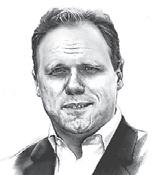
It isn’t “anti-Asian” as some on the far left claim. 59


If banning Huawei was easy, why can’t Washington completely ban TikTok? 61
Declining bond value has caused huge losses for central banks. 62

The CCP has long used economics to overthrow the United States
For many years, a great many very smart people in America believed that capitalism was slowly but surely bringing freedom to communist China, that the Beijing regime at some point in the not-very-distant future would cease being the enemy of the free world, and that our national security policies today should reflect that welcome longterm development.

In recent days, however, there were two additions to the mountain of evidence that these smart people weren’t as smart as they thought. The first was more than half of House Democrats in the new Congress voting with Republicans to pass legislation to stop President Joe Biden from selling any more oil from the nation’s emergency Strategic Petroleum Reserve to China or Chinese companies.
It was a bipartisan acknowledgment that economics has long been part of the CCP’s global strategy to upend the United States as the world’s lone superpower.
Since 2015, Beijing has lavished 10 industrial sectors within China with state cash in pursuit of global dominance. These include artificial intelligence, aerospace, biotech, robotics, transportation, solar cells, and software/information technology. Chinese companies are investing in microchip firms all over the world.
And since at least the late 1990s, China has been seeking to end the dominance of the U.S. dollar as the global trading currency and to cultivate a commodities trading system that relies on the yuan.
China’s $1 trillion-plus Belt and Road Initiative entices third-world nations into debt for dubious projects like “a high-speed rail line
in Laos that will cost equivalent to half the country’s GDP.” In Ethiopia on Jan. 11, Chinese foreign minister Qin Gang got testy when addressing the matter of saddling Africa with debt, calling the charge merely a “narrative trap.”
nese provinces conduct activities apparently ranging from renewing Chinese driver’s licenses to harassing anti-regime dissidents living in America. Last year, federal prosecutors charged more than a dozen U.S. residents with crimes related to such activities at the behest of the Beijing regime.
But recent revelations regarding the Chinese-funded multibillion-dollar Mombasa-to-Nairobi rail project in Kenya show that, among other corrupt stipulations, the loan involved requires that disputes be arbitrated only in Beijing without any right to appeal and that the contract is governed completely by communist China’s laws.
The military dimension is clear; for instance, after convincing Sri Lanka to borrow from Chinese banks to fund new infrastructure at its Hambantota port, the island nation found itself in default when the project turned out to be a commercial flop. Beijing ended up with control of an invaluable naval asset, close to its adversary India.
The second development quashing whatever remaining bullishness there is among observers regarding mainland China is the FBI raid last fall of what is fantastically being referred to as a “Chinese police station” in Manhattan’s Chinatown. It’s just one of more than 100 “overseas service stations” operating illegally in the United States and dozens of other countries in which law enforcement personnel of various Chi-
Bill Clinton, four months into his presidency in 1993, made the case for most favored nation status for mainland China. “The residents of Shanghai and Guangzhou are far more motivated by markets than by Marx or Mao,” Clinton declared. “We are hopeful that China’s process of development and economic reform will be accompanied by greater political freedom. In some ways, this process has begun. An emerging Chinese middle class points the antennae of new televisions toward Hong Kong to pick up broadcasts of CNN. Cellular phones and fax machines carry implicit notions of freer communications.”
The sustained prosperity of South Korea hasn’t been able to budge North Korea an inch from its totalitarian oppression of its own people. It may make no sense to a Westerner for Chinese leader Xi Jinping to see Hong Kong, Taiwan, and Japan and not recognize the advantages of liberty for his people. But it was Rudyard Kipling, recognizing such arrogance, who warned in his short story “The Man Who Was”: “Asia is not going to be civilized after the methods of the West. There is too much Asia, and she is too old.”
Xi also no doubt remembers that his predecessor, the founder of the state over which Xi now has full, apparently permanent control, Mao Zedong, said in 1927, “Political power grows out of the barrel of a gun.”
Since 2015, Beijing has lavished 10 industrial sectors within China with state cash in pursuit of global dominance.
There’s a ne W sheriff in town, and his name is Mike Gallagher. The congressman from Wisconsin will chair the House Select Committee on the Strategic Competition Between the United States and the Chinese Communist Party.
The committee was established by a largely bipartisan vote on Jan. 10, and none too soon. Given the CCP’s increasingly militaristic and genocidal policies, it’s time to stop mincing words. The war that the CCP threatens against Taiwan, for example, would be devastating not only for Taiwan and China, but likely for the U.S. military.
The committee is being cheered as a much-needed bipartisan effort to correct deficiencies in the U.S. strategy against the CCP, including by showcasing the need to increase U.S. military defenses, strengthen our economy, diversify supply chains, and decrease Beijing’s ability to profit off U.S. largesse.
“I think a large part of what we need to do is explain to the American people, explain to our colleagues and by extension the American people, why this matters,” Gallagher told the Voice of America. He wants to make clear that communist China isn’t just a “distant” territorial threat over “claims in the South and East China Sea, or some obscure discussion about microelectronics.”
Gallagher said he wants to connect those broader geopolitical concerns to the “day-to-day reality for Americans and explain why this is ... the biggest challenge of our time.”

The vote in favor of the committee, which included all House Republicans and more than two-thirds of House Democrats, promises a more energetic Congress on the China issue.
On Jan. 12, the House voted for a bill that would ban the sale of U.S. Strate-
gic Petroleum Reserve oil to China or Chinese companies.
The bipartisanship on China is even splitting the far-left “Squad” in the House. One of its members, Rep. Ilhan Omar (D-Minn.), voted for the committee. She has taken a strong stand supporting the Uyghurs, which may explain why she broke with other Squadistas.
police stations abroad—including in the United States, Canada, Britain, France, Germany, and Italy—the true threat to Asians in North America and Europe is the CCP, not an anti-CCP committee that would attempt to restrain Beijing from prejudicially targeting and coercing ethnic Chinese on democratic soil.
Gallagher recognized as much in his floor speech about the committee. “It is here at home that the party’s extraterritorial totalitarianism terrorizes Chinese students studying at our universities and targets Americans of Chinese descent,” he said.
Two from the far left who voted against the committee “expressed positions in line with those of controversial think tanks and advocacy groups in Washington, which often carry water for foreign authoritarian regimes, such as Code Pink and the Quincy Institute,” wrote Jimmy Quinn in the National Review.
Both groups praised Rep. Jamaal Bowman (D-N.Y.) for his vote against the committee.
According to Quinn, the two groups “played a leading role in 2021 advocacy campaigns that sought to pressure lawmakers to vote against legislation sold as necessary to counter China.”
Some on the far left cited concerns that the committee could foster anti-Asian hate, which is an increasingly tone-deaf argument that self-servingly conflates Asian Americans and the CCP in a manner that is itself arguably racist. By hyping the threat of anti-Asian hate, the far left has found yet another excuse to delay addressing racist threats from the CCP.
As shown through frequent revelations about the more than 100 Chinese
The far left’s conflation of the CCP with Chinese Americans is likely not the only reason that significant segments of the Asian American population are starting to abandon Democrats. Many Asian Americans in New York, for example, are leaving the party for its failure to effectively address crime.
But let’s also admit that members of both parties have kicked the can down the road for so long that Americans, and Asians in Asia, face a relatively unfettered and increasingly militaristic and abusive regime in Beijing. The worst anti-Asian hate comes from the CCP itself, in genocidal form against Uyghurs and practitioners of Falun Gong.
If we really want to stop the world’s worst hate crimes against Asians, we should start with the CCP, which targets an ethnicity and religion for total eradication, even if primarily through coercion rather than killing. That fits the U.N. definition of genocide, a definition that’s purposefully broad to nip genocide in the bud rather than wait until its bloody end.
What should be called the new anti-CCP committee is an important bipartisan step in defending ourselves and others, before the CCP’s genocides and militarism get any worse.
It’s not ‘anti-Asian’ as some on the far left claim
The committee is being cheered as a much-needed bipartisan effort to correct deficiencies in the U.S. strategy against the CCP.
Recent jobs growth does not ensure a ‘soft landing’
Hiring remains strong. Some have pointed to this recent robust jobs growth as a reason to downplay other signs of economic weakness and dismiss talk of a recession. At least one headline used the jobs figures to forecast a “soft landing” for the economy.
But a deeper look into the production figures points to a very different direction. It suggests an unsustainable pattern of labor hoarding that will force a recessionary adjustment in the not-too-distant future.
The popular Labor Department “Employment Situation” report feeds the optimistic thinking. In December 2022, its national survey of employers indicated that the roster of workers has risen by some 223,000. A separate survey of households was still more impressive. It recorded an employment gain of 717,000. Jobs growth figures for recent months fall short of monthly employment gains recorded in 2021 and the first half of 2022. Still, they exceed broad historical averages by a wide margin. With data like this, it’s easy to see why many conclude that business is building up its staffing for a major expansion in production.
Other data, however, call into question the likelihood of such an expansion. Consumers, for example, have cut back on their spending. Retail sales have shown flat to negative real growth during recent months, a sharp correction from great strength in 2021 and earlier in 2022. New home purchases are running 23 percent below year-ago rates. New home construction is down 27 percent over the same period. Business spending on equipment and intellectual property has held up.
Still, spending on new facilities
has been in decline for some time, suggesting that the funds are flowing into efficiency and labor substitution rather than a general expansion. Even then, the increase in business investment spending has slowed markedly from 2021 and earlier last year.
managers highly reluctant to cut back on staff, even in the face of falling production levels. No employer wants to go through the expense and bad feelings or layoffs under any circumstances, especially if a change in circumstances could leave the firm short-staffed, as was the case not too many months ago.

Though these separate lines of information—the jobs on the one hand and spending measures on the other—seem to contradict each other, they do yield to reconciliation. Such a squaring of the circle emerges from productivity data offered in another less-than-widely quoted Labor Department report. It shows clearly that the new workers hired of late are grossly underutilized.
Consistent with the robust hiring, it reports an impressive 3.0 percent annual increase in the hours worked over the first three quarters of 2022, for which data are available. But for all these additional work hours, the report shows barely any increase in output, only 0.2 percent at the annual rate. Productivity— output per hour worked—has plummeted during this time, falling at a 3.1 percent annual rate.
It appears that instead of staffing for increased production, business is hoarding labor. The impulse to do that is certainly understandable. Memories of the severe labor shortages back in 2021 and early 2022 surely are enough to prompt managers to hire qualified labor even in the absence of immediate staffing needs. However, memories of those shortages would make
Such hoarding might be reasonable if there was a chance that business activity might pick up in the next few months. That prospect, however, seems highly unlikely. The consumer spending slowdown reflects the ill effects of inflation on the buying power of household incomes. That matter is not likely to turn any time soon.
At the same time, the continued interest rate increases contemplated by the Federal Reserve seem set to apply additional downward pressure on homebuying and homebuilding for at least for some months to come. Business isn’t likely to see the sudden pickup that might justify holding all the excess staff on the payrolls, which is clearly evident in these data.
Rather than a “soft landing,” this picture suggests something very different. It points to a staffing adjustment in the near future. Businesses can’t remain profitable and sustain idle or underutilized employees for long. With hourly compensation for these workers on the rise at almost a 3 percent annual rate, unit labor costs have been rising at a 6 percent annual rate. This fact not only points to continued pressure to raise prices into 2023 but, more critically, an increasingly urgent need for businesses to adjust.
Soon, the nation will begin to see a reluctance to hire new workers and even adopt a tendency toward layoffs, as is already evident in the technology and financial sectors.
It appears that instead of staffing for increased production, business is hoarding labor.

If banning Huawei was easy, why can’t Washington completely ban TikTok?
President Joe b iden signed legislation in December 2022 banning federal employees from using TikTok on government devices because of national security threats. Meanwhile, more than 25 states have taken measures against the popular video app, either by prohibiting its usage on government devices or filing litigation.
Some believe that these measures are good but not enough. They contend that the app should be fully outlawed in the United States because of mounting concerns that it could be used to spy on Americans. TikTok has become the most popular mobile app in the country, with roughly 100 million monthly active users.
Legal experts argue that the Biden administration is being more careful than its predecessor to avoid legal challenges. Since content shared on TikTok is considered free expression, it enjoys protection under the First Amendment.
Arthur Herman, a senior fellow and director of the Quantum Alliance Initiative at Hudson Institute, disagrees that legal hurdles are the main problem. Despite the gravity of the threat, Herman told The Epoch Times that the Biden administration “has been reluctant to really push on the China front.”
In his final months in office, President Donald Trump attempted to ban TikTok through an executive order; however, numerous federal courts struck his order down. After Biden took office, he revoked Trump’s executive order. Biden suggested using an “evidence-based approach” to find out if TikTok was a real threat to U.S. national security.
Herman claimed that due to the administration’s reluctance to act in the past two years, Congress and
Since content shared on TikTok is considered free expression, the app enjoys protection under the First Amendment.
dozens of states had taken matters into their own hands and blocked the app on government devices as a first step. He believes, in the next two years, Congress will be the driving force behind a total ban on TikTok.
The Committee on Foreign Investment in the United States (CFIUS), an interagency government panel, has been negotiating with TikTok for more than two years.

The Biden administration has been reportedly looking into ways to divorce the app from its Chinese owner, Beijing-based ByteDance Ltd. However, there are opposing viewpoints within the administration, causing a stalemate, according to a Wall Street Journal article.
The White House didn’t respond to a request for comment.
Fred Cate, a law professor and vice president of research at Indiana University, says that the U.S. government has vast powers if it believes a company is threatening national security.
But it all comes down to gathering sufficient evidence, said Cate, who specializes in information privacy and security law.
The judges didn’t find the evidence compelling enough to justify the violation of the Constitution’s First Amendment rights, he told The Epoch Times.
“A lot of people have pointed to the bans on Huawei, the equipment manufacturer, and said, ‘Look, if they can ban Huawei, they can ban TikTok.’ That, of course, is not true because Huawei makes equipment, and TikTok is primarily in the business of speech. And so, the First Amendment applies to TikTok, it probably doesn’t apply to Huawei.”
The Biden administration can’t force a sale, according to Cate, but they can make life difficult for TikTok over the next two years if its U.S. business isn’t spun off into a separate entity.
“I think everybody suspects that might be how this resolves itself,” he said.
Some legal experts say TikTok’s parent ByteDance can also be listed on the Commerce Department’s Entity List, a trade restriction list. But that might not fully address the problem, according to Cate.
Through trade restriction, the U.S. government can compel Apple and Google to remove TikTok from their app stores. However, this step would have no effect on the 100 million Americans who already have the app on their phone, he noted, and it could also be challenged in courts by users or the platforms.
Despite the hurdles, Cate is optimistic that Washington will soon find a resolution.
“The economic forces are so strongly in favor of finding a resolution that I would fully expect we’re going to find one and find one soon.”
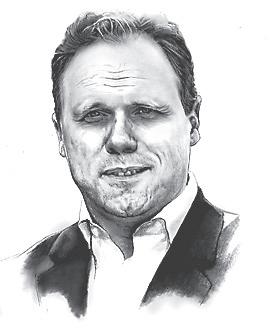
In 2022, central banks purchased the largest amount of gold in recent history. According to the World Gold Council, central bank purchases of gold have reached a level not seen since 1967.
The world’s central banks bought 673 metric tons in the first three quarters of 2022, and in the third quarter alone, the figure was almost 400 metric tons. This is interesting because the flow from central banks since 2020 had been eminently net sales.
Why are global central banks adding gold to their reserves? There may be different factors.
Most central banks’ largest percentage of reserves are U.S. dollars, which usually come in the form of U.S. Treasury bonds. It would make sense for some of the central banks, especially China’s, to decide to depend less on the dollar.

Central banks have been talking about the idea of issuing a digital currency, which would completely change the way money works today. By issuing a digital currency directly into a citizen’s account at the central bank, the financial institution would have full access to savers’ information and, more importantly, would be able to accelerate the transmission mechanism of monetary policy by eliminating the channels that prevent higher inflation from happening: the banking channel and the backstop of credit demand.
What has kept inflation from going up much more is that the way monetary policy is passed on is always slowed by the demand for credit in the banking system. This has obviously led to a huge rise in the prices of financial assets and still caused prices to go through the roof when the growth in the money supply was used to pay for government
spending and subsidies.
If central banks start issuing digital currencies, the level of purchasing power destruction of currencies seen in the past 50 years will be exceedingly small compared with what can occur with unbridled central bank control.
In such an environment, gold’s status as a reserve of value would be unequaled.
There are more reasons to buy gold.
The performance of gold in U.S. dollars may have disappointed investors in 2022, even though it was flat, but in a year of broad financial asset declines, gold rose in euros, pounds, yen, and the majority of emerging currencies.
Central banks need gold because they may be preparing for an unprecedented period of monetary devastation.
The Financial Times claims that central banks are already suffering significant losses as a result of the
falling value of the bonds they hold on their balance sheets.
If a central bank experiences a loss, it can fill the gap by using any available reserves from prior years or by requesting help from other central banks. Similar to a commercial bank, it may experience significant difficulties; nevertheless, a central bank has the option of turning to governments as a last resort. This implies that the hole will be paid for by taxpayers, and the costs are astronomical.
The wave of monetary destruction that could result from a new record in global debt, enormous losses in the central bank’s assets, and the issuance of digital currencies finds only one true safe haven with centuries of proven status as a reserve of value: Gold. This is because central banks are aware that governments aren’t cutting deficit spending.
These numbers highlight the enormous issue brought on by the recent overuse of quantitative easing. Because they were unaware of the reality of issuer solvency, central banks switched from purchasing low-risk assets at attractive prices to purchasing any sovereign bond at any price.
Why do central banks increase their gold purchases just as losses appear on their balance sheets? To increase their reserve level, lessen losses, and foresee how newly created digital currencies may affect inflation. Since buying European or North American sovereign bonds doesn’t lower the risk of losing money if inflation stays high, it’s very likely that the only real option is to buy more gold.
The only reason central banks buy gold is to protect their balance sheets from their own monetary destruction programs; they have no choice but to do so.
The declining bond value has caused huge losses for central banks
Central banks need gold because they may be preparing for an unprecedented period of monetary devastation.
Gold investors should pay close attention to the dollar
fter a tumultuous several months, gold prices enjoyed a decent run-up in Q4 2022. The price movement was helped by the dollar’s retreat, hopes that the Federal Reserve will slow down its aggressive monetary tightening, and renewed demand for the metal from emerging markets.
Is this the beginning of a multiyear bull market in gold?
To be fair, gold investors have endured years of underperformance. Gold closed 2022 on two consecutive down years.
The World Gold Council, in its 2023 outlook report, said gold will enjoy a “stable but positive performance” in the year ahead. It isn’t an outright bullish view, as central banks around the world will continue to maintain a strong bias to fight inflation—and keep interest rates high, a deterrent to gold price increases.

But recession is near inevitable in many economies. Gold typically performs very well in a classical recessionary economic environment.
Another supportive fact pattern to a rebound in gold price is the continued decline in the U.S. dollar. The World Gold Council’s research indicates that peaking dollar value has historically been positive for gold, with a positive spot price movement during the 12 months after the dollar has peaked.
Gold investors should pay close attention to the dollar. Gold’s approximately 10 percent price increase during the fourth quarter of 2022 very closely tracked the dollar’s decline during the same period.
Cooling inflation—and therefore rate-hike expectations—is only one factor going against the dollar. Another factor is improving expectations for economic growth outside
the United States, such as in China and Europe.
China’s reopening will put further pressure on the dollar. Beijing during the last week of December 2022 announced the rollback of inbound quarantine in January. This measure is expected to boost the local economy and stimulate foreign investment in the country.
Geopolitical risk is another major determinant of gold prices. Political uncertainty and war make gold a valuable tail risk hedge.
Saxo Bank’s Head of Commodity Strategy Ole Hansen recently predicted that gold will top $3,000 per ounce in 2023 due to “war economy mentality of self-reliance and minimizing holdings of foreign FX reserves, preferring gold.” This coincides with another prediction that countries will move to invest in locking in energy and commodity resources
as well as supply chain security. In addition to gold itself, Saxo is also bullish on junior gold miners.
No doubt this view has been informed by the ongoing war between Russia and Ukraine, and China’s continued saber-rattling against Taiwan. Russia’s largest bank—Sberbank—on Dec. 26, 2022, announced the launching of a gold-backed digital financial asset, claiming that it offers an “alternative” investment amid de-dollarization.
Central banks were some of the biggest buyers of gold last year. In Q3 2022, central banks added a record 399 tons of gold, according to World Gold Council data. Among them, China has been one of the biggest buyers. Beijing is well known for its intentions to cut U.S. dollar dependency, and it had a front-row seat to Russia being locked out of the dollar-dominated global financial system, faced with price caps and sanctions against its energy exports and its overseas foreign exchange assets frozen.
There have been rumblings of BRICS nations (Brazil, Russia, India, China, and South Africa) and their allies banding together to develop a new reserve currency backed by commodities such as gold and oil. No such plans have been officially announced, but certain BRICS nations have been preparing to diversify away from the U.S. dollar for years.
Despite the positive backdrop, there are risks that gold will continue to underperform.
The worst-case scenario would include more interest rate increases by the Federal Reserve and keeping monetary conditions tight despite an economic recession. However, this policy path would go against the Fed’s recent history and philosophy.
Geopolitical risk is another major determinant of gold prices. Political uncertainty and war make gold a valuable tail risk hedge.THOUGHT LEADERS

Promoting division and buying off elites are part of the CCP’s unrestricted warfare playbook
“The overt goal of China is to be No. 1 in the world in comprehensive national power.”
Cleo Paskal, nonresident senior fellow, Foundation for Defense of Democracies
Each country has a comprehensive national power numerical value,” says Cleo Paskal, a leading expert on China and the Indo-Pacific region, “and the overt goal of China is to be No. 1 in the world in comprehensive national power—economically and militarily.”
In this episode of “American Thought Leaders,” host Jan Jekielek discusses the Chinese Communist Party’s (CCP) strategy in the Pacific with Paskal, a senior fellow at the Foundation for Defense of Democracies. Paskal breaks down the CCP’s moves in the region, from promoting division, and buying off the elites of small island nations, to its ultimate ambition of taking control of Taiwan.
JAN JEKIELEK: You wrote a fascinating article, “China Winning Entropic Warfare in the Pacific Islands.” What’s going on there?
CLEO PASKAL: First, let’s define the term entropic. A state of entropy is when things start to fall apart, or fragment and become chaotic. If you look at how the Chinese Communist Party conducts its political warfare and targets countries, part of it involves entropic warfare. A core component of that foreign policy, as we see in the Chinese think tanks, is comprehensive national power.
It’s a term that the Chinese use to rank countries; an empirical metric. Each country has a comprehen-
sive national power numerical value, and China’s overt goal is to be No. 1 in the world in comprehensive national power—economically and militarily. If you have a rare earth mineral mine in your country and a Chinese company is mining it, they count that toward their comprehensive national power, not yours, because it’s feeding into their systems.
It’s very empirical, and it’s a little bit insane. The Chinese Communist Party thinks it can break everything, even humanity, down into numbers. But it’s an important driving force.
According to this view of comprehensive national power, there are two ways of improving your relative ranking. One is the typical American way, where you work hard and get better.
The other is you knock everybody else down. If you’ve knocked them down, you’re doing better than they are.
From a comprehensive national power perspective, this explains why it is beneficial to the Chinese Communist Party to
pump fentanyl into middle America, because it destroys communities and families. Entropic warfare creates this disintegration within a target country.
Unrestricted warfare is another Chinese term. It’s the name of a 1999 book by two PLA [People’s Liberation Army] Air Force colonels about methods of warfare against enemies like the United States. They listed 24 different types of warfare, including drug warfare.
So, we’ve got two Chinese terms: comprehensive national power and unrestricted warfare. They look at a country and if they can do elite capture, they prefer to do that. They get the country through the elite leaders. If they can’t do that, then they use unrestricted warfare to wage entropic warfare to disintegrate and weaken those societies, so that resistance to Chinese coercion is lessened.
They tend to identify authoritarian leaders and then back them. In the case of entropy or civil war, an authoritarian leader has an advantage, especially
if they’re backed with PRC assets and intel. This is exactly what happened in the Solomon Islands during a three-year period. In 2019, the Solomons switched from recognizing Taiwan as China to recognizing the People’s Republic of China [PRC].
MR. JEKIELEK: How did that happen?
MS. PASKAL: The usual elite capture. And we’ve forgotten how important the Pacific Islands are strategically. The Solomon Islands are the home of the Battle of Guadalcanal, which was just over 80 years ago this past summer. This was a highly strategic location that the Japanese needed to control if they were to control Australian access into the region. And the Americans needed to control it if they were going to push back the Japanese.
That movement was very closely studied by the Chinese. They learn a lot from history. They’re trying to do with political warfare what was bought in blood by the Americans during the liberation of the region.
This time, China got the Solomons by buying off the right people. At that 80th commemoration of Guadalcanal, all these high-level people came for this commemoration. There were Japanese and American representatives. But the prime minister of the Solomon Islands didn’t show up, because he’s so deep in China’s pocket.
The Solomons switched in 2019 from Taiwan to

China, and also signed a security agreement with the PRC allowing the deployment of Chinese military personnel to protect Chinese citizens and assets in the Solomon Islands at the request of the Solomon Islands’ government.
They also bought off 39 of the 50 members of Parliament, which was enough to change the constitution to delay elections. This is what happens. A pro-PRC authoritarian leader sets the groundwork to delay elections, and if there’s a civil war because of it, that’s fine with him, because his Chinese backers will keep him in power. That’s entropic warfare.
MR. JEKIELEK: So there is this whole idea of wanting to establish the rest of the world as vassal states to the CCP. Is that how you see it?
MS. PASKAL: Yes. There is the imperial vassal state, and you pay your tribute. And the advantage of doing this in the Pacific islands is that they are very small. The Solomons are 350,000, 400,000 people, something like that. You can see the mechanisms a lot more clearly. You can see who China is targeting, and what they’re going after. You can see them going after democracy and the judiciary and the media.
Three countries—Palau, the Marshall Islands, and the Federated States of Micronesia—through the voluntary Compact of Free Association have given over their defense and security to the United States. They literally trust their lives to
the United States. These Pacific Islands are small, but when you look at the zone they cover, they are as large as the continental United States.
If you have that zone and Guam and the Marianas, which are part of the United States, the security perimeter of our country goes from Hawaii all the way to just behind the Philippines. It’s very important strategically. Those countries are independent countries, and they have these Compacts of Free Association with the United States.
MR. JEKIELEK: So this is of much greater importance to the United States than many people realize. Let’s jump to Taiwan because this is the critical question.
MS. PASKAL: If you want to take Taiwan—and we know that the Chinese want to take Taiwan—and you plan on holding Taiwan, you need to have functional control in at least that band of Pacific Islands. And if you go down the map and you’ve got the Solomons and PNG and maybe Vanuatu, then you can cut off the Australians and the New Zealanders. It’s also a lot more difficult for Japan to come down from the north.
If they take Taiwan, then what will the American allies in the region think? Will the Philippines think the United States is going to back them? What will the Japanese do? What will the Malaysians and Indonesians do? You’d get a whole band of failure in the U.S. ability to protect allies and partners in the region.

MR. JEKIELEK: Some people might be thinking that the United States is already way over-extended Why are Taiwan and that whole region so important at this stage?
MS. PASKAL: This is a battle of systems. So you have a choice. You have a choice of a system that’s happening in the Solomons, where you accept the Chinese Communist Party. Or you live a free life in the faith of your choosing with the people you care about. And the Chinese Communist Party is fundamentally expansionist. They don’t know how to not expand. And if China takes Taiwan, the United States will have demonstrably failed at defending a successful democratic society. That is a key component of the strategic architecture of the Indo-Pacific. It’s a very, very big win. Taiwan is incredibly important strategically, philosophically, economically, and any way you can imagine. That’s why China wants it.
MR. JEKIELEK: And not to mention chip manufacturing.
MS. PASKAL: Yes. The chip manufacturing is important, but when you get back to comprehensive national power, it’s like COVID.
Wherever COVID came from, China knew it had a problem, and what did they do? They blocked internal flights and allowed external flights, so it was allowed to spread.
They turned a domestic epidemic into a global pandemic. Because if your mentality is comprehensive national power, you’re going to take a hit when you know you’ve got a problem. But if everybody else takes a hit, and you use that moment to position yourself, you can come out relatively ahead, which they did. The same thing with the chips. If the chip manufacturing is destroyed, it hurts China, but it also hurts everybody else. If they can be in a position where they’re hurt relatively less, they come out ahead.
This interview has been edited for clarity and brevity.

We should actively strive to create a worthy legacy
 By Jeff Minick
By Jeff Minick
In “ l ive l ife in c rescendo: Your Most Important Work Is Always Ahead of You,” Stephen Covey set out to answer questions such as “How can you pull yourself out of a midlife crisis?” and “How can you contribute once you’ve achieved success?” Covey died before finishing “Crescendo,” but his daughter, Cynthia Haller, who had worked alongside him, completed the project.
Early on in “Crescendo,” Covey and Haller address some of the challenges facing men and women in their late 30s to their early 60s, especially during those tough times when they feel overworked and underappreciated, struggle in their marriages, or believe they’ve failed to fulfill their potential. Signs of that fatigue and sense of failure include burnout, depression, a lack of direction, or attempts to regain their lost youth by “dressing and acting like a teenager,” or worse, abandoning their families “to find themselves.”

Covey and Haller then offer readers help and advice in chapters with titles like “People Are More Important Than Things,” a wise reminder to value our loved ones more than our work. But the title that struck home with me belongs to the first chapter, “Life Is a Mission, Not a Career.”
We Americans are very much career- and work-oriented. Assured that education will bring us success, many of us jump through hoop after hoop—high school, college, further
professional training, internships—all in the hope of finding work that will deliver satisfaction and money.
Ask people what sort of work they do, and the replies trip off the tongue: surgeon, mason, software sales rep, stay-at-home mom.
I realized that each of us is actually pursuing several different missions.
Ask them “What’s your mission in life?” and confusion reigns.
That question occurred to me while reading “Crescendo’s” first chapter, and an answer proved difficult. I’m an old guy who can tick off his accomplishments and failures, but have I lived my whole life with a sense of mission guiding me along life’s rocky pathways? Not really.
Some people with a strong religious faith know their mission. In the Baltimore Catechism, for example, used years ago by Catholic schoolchildren, we find the question “Why did God make you?” and this answer: “To know Him, to love Him, and to serve Him in this world, and to be happy with Him forever in Heaven.”
Now, there’s a mission statement, plain and simple.
Few of us, I suspect, have so clearcut a mission statement, yet as Covey tells us this concept is vital to our
well-being. Wrapped up in that term are things like our purpose in life, our goals, and our loves. And if we do experience a midlife crisis, that dreary condition may stem from forgetting or failing to discern and live out our mission, our reason for being on this earth.
Reading “Crescendo,” I realized that each of us is actually pursuing several different missions. The 40-year-old attorney who’s married with two children and coaches his daughter’s soccer team has several missions: working for his clients, loving and caring for his wife, raising his children to be adults, and teaching young girls the rules and tactics of a game, as well as sportsmanship.
His overall mission then becomes a matter of priorities and balance. What’s most important to him should head the list.
And because all missions end with the attainment of a final objective, surely the goal of a life mission is our legacy. What memories and lessons will we leave to others? What will we have added to the world?
A worthy life mission acts as the guiding star necessary for the creation of our best selves and a future of vision and hope.
Jeff Minick lives and writes in Front Royal, Va. He is the author of two novels, “Amanda Bell” and “Dust on Their Wings,” and two works of nonfiction, “Learning as I Go” and “Movies Make the Man.”
Because many fans of the links enjoy talking about the dream courses around the world they want to play, we’ve collected a few strong candidates to consider.
A SHORT DRIVE FROM Chile’s capital city of Santiago, the Santa Rita vineyards resort offers visitors a unique mix of history and outstanding wine. 72

Mulled ale is your new favorite drink to warm up on a frosty evening. We’ll explore how to create your own signature recipe. 75
OFFERING ONE’S SERVICES to others, from leading a scout troop to being an usher at the opera, can be a way to help others while making new friends. 83
The winery with a unique brick and copper-spired “chapel” tasting facility and casual seating areas is set behind the residence, accented by the equestrian facilities and the vineyards.

CANADA
Set in scenic b ritish c olumbia’s fertile Fraser Valley, this sprawling nine-acre working estate is accessed via a private, winding, stone-lined road leading through 4 1/2 acres of lush vineyards to a circular court and a classically styled, 6,000-square-foot, fivebedroom, five-bath residence.
The Canadian estate features extensive equestrian facilities and is the home of the award-winning Seaside Pearl Farmgate Winery.
The residence has many remarkable features, including a Renaissance-style mural adorning the ceiling of the entryway, vaulted ceilings in the living room and dining room, gleaming marble and wood flooring, and exquisite custom millwork throughout. The generously sized kitchen with restaurant-grade stainless-steel appliances is a chef’s delight, equipped with an island with a gas stove and expansive granite countertops for meal preparation, as well as under-counter storage and an overhang with barstools for casual dining. Centrally located at the foot of the stairs leading to the bedrooms, it serves as a natural gathering point in the home.
The adjacent formal dining room is illuminated by a spectacular chandelier, making it a
perfect setting for entertaining. The airy and spacious master bedroom features a fireplace that will be greatly appreciated on chilly evenings, crown molding, and an adjacent oversized master bath with marble flooring, large windows to bring in natural light, his and hers vanities, gleaming wood cabinetry, and a large walk-in shower.
The property’s vineyard and winery are well known for unique varietals of Petite Milo and Cabernet Foch, which thrive in this region. The winery features a cavernous tasting room ideal for large gatherings, a most unique brick and copper-spired “chapel” tasting room, and an outside tasting area with a view of the equestrian riding ring to one side and the vineyards to its rear. Horse lovers will be thrilled by the riding ring, 13-stall stables, and arena. The property also features an indoor ice rink.
The Fraser Valley is located in the middle of British Columbia’s most fertile agrarian district, about an hour from Vancouver. This area has a warm country community atmosphere, offering residents serene landscapes and a peaceful lifestyle.
Phil Butler is a publisher, editor, author, and analyst who is a widely cited expert on subjects ranging from digital and social media to travel technology.
5290
• 6,000 SQUARE FEET
• 5 BEDROOMS, 5 BATHS
• 9 ACRES
KEY FEATURES
• EQUESTRIAN FACILITIES

• VINEYARDS
• AWARD-WINNING WINERY
• PRISTINE COUNTRYSIDE AGENT SOTHEBY’S INTERNATIONAL REALTY CANADA PAUL HAGUE 604-328-7760
(Above) The large kitchen provides the chef plenty of room to work, with restaurant-grade appliances and a huge island with a gas stove, ample storage areas, and a casual dining area.

(Top Right) The winery’s cavernous tasting room is an ideal setting for large gatherings. (Right) Horse lovers—and their steeds—will be enthralled with the estate’s spacious stables.


Cradled by arid mountains and reached by a winding two-lane road, everything was peaceful there, in the middle of a Friday afternoon. You would never guess that just to the north—less than an hour’s drive away—sits the southern reaches of one of South America’s great metropolises. Later, I’ll fight the traffic. But that seems a million miles away as I rolled up just in time for the final tasting tour of the day.
Moments into the tour, the guide, Victor, led me through a gate into a completely unexpected space—a lush, rambling, secret garden. Later, I’ll walk through a wholly invented ruin. And after that, a little time in a basement with blood-spattered mannequins. It’s the strangest, loveliest wine tour I’ve ever taken.
Chilean wine rarely gets the respect it deserves, despite the fact that the country is the world’s fifth-largest exporter. Many of its varieties are grown in a hot, dry climate similar to the Mediterranean, so big reds predominate, from cabernet sauvignon to merlot and syrah. But the country also produces good white wines, including chardonnay, viognier, and riesling.
On this day I was at Santa Rita, a winery very well-known among Chileans. Victor told me it was named for the patron saint of impossible causes.
“If you have something bothering you, pray to Santa Rita,” he said with a hint of a smile. “And, of course, drink a glass of Santa Rita wine.”
While its appellations are rooted firmly in the New World, wine came early to Chile, with Spanish conquistadors planting vines way back in the 16th century. It wasn’t until the 1800s that French grapes arrived, but the current boom happened much later. Between 1995 and 2005, the number of wineries in Chile increased more than five-fold.
The hacienda here at Santa Rita dates to 1790, although the first grape plants weren’t in the ground until 1880. The winery was founded by a businessman named Don Domingo Fernández Concha, a cousin of the founder of Concha y Toro.

Concha was very religious, a big believer in Santa Rita, and gave his winery her name. We strolled through the vast, lush gardens, called Centenario Park, which cover almost 100 acres. The property also includes orange, almond, and eucalyptus trees, a 16-room luxury hotel housed in the original estate, now called Casa Real, and a private, neo-Gothic chapel, which feels more like a scaled-down cathedral.
barrels per week.
Santa Rita is about a 40-minute drive from central Santiago.
Cabernet sauvignon is Chile’s most important red variety, and it’s fruity and spicy.
The grape has become a signature variety for both Chile and Santa Rita.

At its peak, the guide noted, more than 100 families lived and worked here.
After a visit to Italy, Concha returned with designs in mind and built some ancient-looking Romanesque baths. The fairly recent “ruins” remain, complete with pillars, a portico, and a big, blue pool.

The next stop: the oldest cellar on site.
“We see ghosts in here hardly ever,” Victor said with a laugh, explaining that the walls were built from limestone, eggs, and sand. It’s stood the test of time, almost—two columns collapsed during an earthquake that registered at an 8.8 magnitude. The cellar is dark and moody, with hundreds of French and American oak barrels aging the good stuff under the low archways. Their most popular export is 120 Reserva Especial, a cabernet sauvignon.
In the “Cellar of 120 Patriots,” I saw a film as well as a museum-like display complete with bloody mannequins, which were bandaged and stretched out on camp beds. They bring to life the day in 1814 when Chilean soldiers, fighting the Spanish crown, came to this place to hide out and recover.
In a place known for the impossible, it’s perhaps appropriate that a grape that once was thought to be dead came back to life. In the 19th century, a pest called phylloxera devastated European vineyards, particularly those in France. Carménère, a Bordeaux red, was wiped out. Or so everybody assumed.
“They thought it was extinct,” Victor said.
But, it turns out, that actually wasn’t the case.
For some 150 years, Chileans had been cultivating what they thought was a second type of merlot. It wasn’t. In 1994, Santa Rita brought in a French expert, an ampelographist from Montpellier’s school of enology.

He identified that second kind of merlot as carménère. It was a surprise to everyone.
“All the winemakers in Chile were shocked,” Victor told me. The grape still grows in abundance all around Santiago, and it’s become a signature variety for both Chile and Santa Rita.
The tour ended, as every trip through a winery should, with a tasting. Together with local meats and cheeses, I sample some of their top bottles.
Soon enough, I’m fighting the late Friday traffic back to the heart of Santiago. A summer sun is fading, lighting up the Andes, just to my right, in orange. And later that night, back in the heart of the city, I dreamed about grapes, once lost forever, now found, and impossible causes somehow accomplished.
Tim Johnson is based in Toronto. He has visited 140 countries across all seven continents.
Fly: Arturo Merino Benítez International Airport (SCL) receives direct, nonstop flights from across the continent, plus Europe and North America.
Getting Around: Ride-share services are a good option if you don’t want to drive, plus the winery offers several transportation choices at Santarita.com.
Stay: Recently renovated and re-flagged, the Radisson Blu Plaza El Bosque offers good rooms and great service.
Take Note: Santa Rita offers a number of different tour options, from basic to premium.

Though lesser known than its wine cousin, the hot, spiced drink is a centuries-old winter warmer
By Kevin RevolinskiWe’re noW in the season when “ice cold” doesn’t necessarily sound like the best thing—maybe even for beer. Winter seasonal beers are often heavier brews, stronger in alcohol or thicker in body and maltiness (think imperial stouts), and get more flavorful as they warm up a bit toward room temperature. But what about flat-out heating the stuff? Cider, wine, and a few cocktails winterize well, so why not beer?
The tradition of mulled beer is perhaps lesser known today than its wine cousin but goes back at least to the 17th century in England. Often considered a health drink that could combat fevers, colds, and other ale-ments, mulled beer was sometimes served with an egg in it, perhaps approaching the heft of a proper meal. Oh, and did I mention workers drank it in the morning as if taking their vitamins?
References and recipes are abundantly from the UK, but the Germans have Glühbier, a sibling to Glühwein (mulled wine), and the Belgians heat up kriek beer with spices as well. Recipes, of course, vary, but typical sweeteners are brown sugar or honey, while common spices include ginger, cloves, cinnamon, cardamom, and coriander, as well as star anise, or even juniper berries, which seem to
Choose a malty ale as your base.
Recipes for mulled ale vary, but are typically sweetened with honey or brown sugar and infused with a medley of warming spices.

• 24 ounces ale or lager, divided
• 2 tablespoons brown sugar
• 1/2 teaspoon ground nutmeg
• 1 cinnamon stick
• 4 cloves
• 2 star anise

• Several long strips orange zest (avoid the bitter white pith)
• 3 to 4 ounces brandy or dark rum
In a pot, mix 18 ounces of the ale with the sugar, spices, and orange peel. Slowly bring to a low simmer; don’t boil. Simmer for about 20 minutes to start, or longer if desired. Remove from heat and add the remaining beer and brandy or rum. Serve in mugs, garnished with an orange slice and cinnamon stick.
beg for gin as an easy and readily available substitution.
Pre-made bottled varieties can be warmed in a water bath of about 105 degrees F, but making your own may be more fun and adjustable to your tastes. Start with a favorite ale or lager, generally something malty; overly bitter hopped beers aren’t the best. The longer you leave it to simmer with the seasonings, the more they’ll infuse, but this also boils off the alcohol eventually. But no worries there: You’ll top it off with more beer and brandy or dark rum off the heat.
To Egg or Not to Egg?

Add some body and texture to mulled beer with a bit of egg. For each serving, separate a yolk from its white (use the white later, maybe for a whiskey sour!), and whisk the yolk very well with 2 teaspoons of sugar, until it looks more white than yellow. Add a couple ounces of the unheated beer to dilute this so it doesn’t go scrambled on you when you add it to the warm mixture. Stir it in and heat the whole mixture for about 5 minutes more, then pour and serve.
Kevin Revolinski is an avid traveler, craft beer enthusiast, and home-cooking fan.
Some recipes add an egg yolk for heft.
A medley of spices infuses the beer with warm flavors.
To those who don’t roam the links, golf courses look alike, but this collection stands apart.
Playing at these spectacular clubs would be a thrill for any hard-core golfer

Some say the game of golf began in Scotland around the year 1450 when players would use a stick to hit pebbles over obstacles and along a pre-determined path. Others claim the Dutch invented the game around 1290, calling it “colf.” It was actually banned in Brussels in 1360, with a fine of 20 shillings and forfeiture of the player’s coat for those caught “colfing.” The following are among the best places in the world to play, without fear of losing a coat.

The oldest and perhaps most iconic of all golf courses, the Old Course at St Andrews in St Andrews, Scotland, has been drawing players since the 1400s. Named for the patron saint of Scotland, the course went quiet for a period in the 15th and 16th centuries when the game was banned in the hopes that young men would instead focus on archery. Activity resumed in 1552 when Archbishop John Hamilton nullified the ban.
There are two ways to play St Andrews: A round for nonmembers costs $260, assuming you show up at dawn and charm the starter into putting your name on the waiting list. Or, you can establish residency in St Andrews and pay $290 to join the St Andrews Links Trust. Members of the Trust have access to the Old Course with its challenging Hell Bunker and Road Hole Bunker. Trust members also have access to the New Course (1895), the Jubilee Course (1897), the Eden Course (1914), the Strathtyrum Course
(1993), the Balgove Course (1993), and the Castle Course (2008). To make the experience even more memorable, consider taking a few lessons at the St Andrews Links Golf Academy.
Sand traps are a challenging feature of all courses, but few compare to those of the course at Saadiyat Beach Golf Club in Abu Dhabi. Designed by Gary Player and built in 2010 on a 300-plus acre site, the course on Saadiyat Island is bordered by the sandy beaches and waters of the Arabian Sea. The par 72-course is festooned with challenges, including a saltwater lagoon, saltwater lakes, massive sand dunes, and 67 bunkers and tees for a yardage of 5,290 feet, or 7,748 for professional events. The course was voted “Best in the UAE” in 2015, “Best in Abu Dhabi” in 2019, and was the site of the first European Ladies Tour event in Abu Dhabi. With five tee positions, the course is an ideal choice for players of all levels, from first-timers to world champions. To play Saadiyat, check for available tee times and book a round. Bring sunblock and stay hydrated to help cope with the sunny, desert environment.
Playing with your own clubs is usually preferable, but for those who travel light, rental clubs allow you to get out on the greens as soon as you arrive.

These world- class courses all have seasoned pros on staff to provide personal lessons, adding a nice touch to an already epic experience.
Donald J. Ross, an apprentice of Old Tom Morris at St Andrews Club, designed the majority of the East and West Courses at Colorado Springs’ Broadmoor.

The game of golf, now enjoyed by millions around the world, began on the lush lawns of St Andrews, quite possibly the ultimate bucket list course.

Those enjoying the course face the same challenges as contenders for the annual Masters Tournament.
The Legend Golf Course is located on the northeastern side of the lush island of Mauritius in the Indian Ocean. Designed by South African champion Hugh Baiocchi in 1994, the par 72-course winds through an indigenous forest once used as a hunting preserve. The most challenging hole is said to be the 17th, which calls for extreme accuracy and range to clear the creek and avoid the sand traps. The course is the home of the Johnnie Walker Classic, the European Senior Tour, and the Mauritius Open, played on new greens recently installed in accordance with USPGA specifications. The course is only open to guests of the Le Prince Maurice and Belle Mare Plage hotels, who aren’t charged a greens fee.

Rocky Mountain Golf
Set amidst the splendor of Colorado Springs’s Cheyenne Mountain Foothills, The Broadmoor’s East and West Courses provide an array of challenges and epic scenery. The West Course combines 10 holes designed by Donald Ross, built in 1918, with eight holes designed by Robert Trent Jones, built in 1964. The East Course is one of only a dozen to receive a 5-star rating by Golf Digest. Chosen as the site of the 2025
U.S. Senior Open, the East Course has hosted events such as the 1959 U.S. Amateur, Jack Nicklaus’s first major win, as well as the 2018 U.S. Senior Open. A private club, the courses are open only to members, guests of a member, or guests of the resort. The cost of a round varies seasonally, from $130 to $295.
Officially founded in 1899, Augusta Country Club is one of the oldest courses in America. Originally known as the Bon Air Golf Club, the four founding members of the club opened the course for play in 1897, bringing the game to the Southern United States. Course access is limited to members and their guests, as well as to members of other private clubs offering reciprocal privileges who provide a written introduction during Masters Week. Those enjoying the par 72-course, which was redesigned by Donald Ross, face the same challenges as contenders for the annual Masters Tournament. The club has hosted the event every year since 1934, except for a brief hiatus during World War II, making every round truly memorable. Golf legends including Jack Nicklaus, Bobby Jones, Alister McKenzie, and others have contributed designs for greens, mounds, swales, and various hazards.
Any list of must-play courses would soon hit triple digits, so this brief collection includes clubs located all over the globe in order to add to the adventure.



Several of these clubs allow the public to play, but greens reservations must be made early. Others are reserved only for members and their guests, so network to befriend members!
While on any of these or other world-class courses, consider taking a lesson from the resident pros as a way to add to the experience and increase your skills.

PELICAN 1910
$36
Looking like a pen when tucked in a pocket or briefcase, this compact dynamo weighs just 1.5 ounces and uses just one AAA battery to project a 106-lumen beam. This combination of small size and an ample beam makes it a good all-around choice for when the power goes off, finding your seat at the opera without blinding others around you, or when you need to find something dropped under your desk.

$47.25
The police’s favorite light comes in a version ideal for the rest of us. Powered by three AAA batteries, it casts a bright beam to erase the shadows. The pushbutton tail cap allows 100 percent power, strobe, an emergency SOS pattern, or instant-on “Nite Lite” mode. Complete with batteries, a pocket clip, and a no-roll lens cap with red, green, and blue filters.



$69.99
This little torch is rechargeable in 3 1/2 hours via a magnetic base to provide up to 120 days of low light, and 1500 lumens of cool or neutral light. A twoway clip keeps it secured to a pocket or a hat brim, while the aluminum housing’s non-slip texture ensures a secure grip, even in rainy conditions.
HELOTEX G2
$25
This tough customer is proof that “tactical” lights don’t have to cost hundreds of dollars. Crafted of aircraft aluminum with O-rings to withstand extreme conditions, the push-button tail cap switch can be set to deliver 120 or 130 lumens of light. It can be powered by either one AA battery or one rechargeable CR123 battery.


$39.95
This eminently practical light can be powered by either three AAA batteries or one rechargeable battery. The adjustable beam has four modes: SOS, strobe, high, and low, and can be adjusted for close-up illumination or zoomed out to illuminate objects up to 1,100 feet away. The rugged aluminum housing protects it from drops or exposure to water.
Are there books you’d recommend?
We’d love to hear from you. Let us know at features@epochtimes.com
Cleave weaves a fascinating love story full of passion and betrayal into the backdrop of London at war with Germany. Using historical records, as well as his grandparents’ love letters, Cleave recreates a chaotic world where love and victory seem out of reach.

SIMON & SCHUSTER, 2017, 448 PAGES
her bedroom and reads a “trashy novel” that stands in stark contrast to real life. The many references to the American past, the hilarious battles between James and Sally, and a finale of redemption mark this as one of Gardner’s finest books.
NEW DIRECTIONS REISSUE, 2005, 399 PAGES
Originally published during the Bicentennial, this novel takes us to Vermont, where we meet James Page, age 72, hard-headed and hard-hearted, and his stubborn sister Sally, 80, who shares his house but not his values. During their uncivil war, Sally holes up in

 By Brendon Simms and Stephen McGregor
By Brendon Simms and Stephen McGregor
The World War II Battle of Midway changed everything. Four Japanese fleet aircraft carriers were sunk. Japan’s advance stopped and its retreat began. This book offers a fresh look and interpretation of the events of the battle. It demonstrates that victory was more than a lucky accident. The U.S. Navy had the Douglass Dauntless dive bomber manned by professional and highly skilled pilots. It shows how and why superb strategic level management put aircraft and aircrews in the right spot.
PUBLICAFFAIRS, 2022, 304 PAGES
The Inklings were the 20th century’s most influential literary circle, which met regularly for decades at Oxford, England. Three of its members, C.S. Lewis, J.R.R. Tolkien, and Charles Williams, legitimized fantasy as a literary genre. This book offers a fascinating examination of how the Inklings encouraged each other, offered one another companionship and constructive criticism, and how their writings impacted literature.

FARRAR, STRAUS & GIROUX, 2015, 656 PAGES
parliamentary Roundheads pitted against the Royalists. Basing House in Hampshire was the stronghold of the Marquess of Winchester, ever loyal to King Charles I. Besieged three times between 1643 and 1645, this is the story of those tumultuous and traumatic events.

PEGASUS BOOKS, 2023, 352 PAGES
Civil war gripped England in the mid-1600s. Chaos reigned with the
 By Mark Twain
By Mark Twain
In this out-of-character novel, Twain explores the life of a girl whom he considered one of the most remarkable human beings ever to grace the planet. The story is told by Joan’s fictional page and secretary De Conte, our 82-year-old narrator who writes to pass on to his descendants the true Joan, her courage, her honor, and her purity in a corrupt and violent age. Twain’s years of study and detailed research give readers a factual account of her deeds and achievements. Twain considered this his favorite of all his books.
IGNATIUS PRESS, 1989, 452 PAGES
Illustrated by the gorgeous scratchboard art of Beth Krommes, this sweet story tells of a child’s bedtime wish to let “all that is heavy turn light.” Snow falls, and with it comes the slow delights of winter. Preschool to third grade.

CLARION BOOKS, 2016, 48 PAGES
Young Amy wants to knit a colorful hat for her grandmother’s birthday. Learning to knit—and doing a good job—requires patience and perseverance. Can she do it in time, and will Grandmother like it? A sweet, familycentric story.
PHOENIX JOURNEY BOOKS, 2022, 33 PAGES

‘Kompromat’ (2023)
In this high-stakes political thriller, Frenchman diplomat Mathieu Roussel (Gilles Lellouche) has been made the new director of the Alliance Francaise in a remote Siberian city. But when he’s framed for a heinous crime, his life is thrust into jeopardy, and he must try to prove his innocence.

Lellouche turns in a convincing and nuanced performance of a political figure on the wrong side of Russian authorities. Based on a real-life case of international espionage, the gritty film, in French with English subtitles, is riveting.
DRAMA | THRILLER
Release Date: Jan. 27, 2023 (U.S.)
Director: Jérôme Salle Starring: Gilles Lellouche, Joanna Kulig, Louis-Do de Lencquesaing Running Time: 2 hours, 7 minutes MPAA Rating: Not Rated Where to Watch: Theaters
In the isolated, snowy environs of Wyoming, a young Native American woman’s body is discovered and the homicide greatly affects the local community. Rookie FBI agent Jane Banner (Elizabeth Olsen) is called in to solve the grisly murder, but she’ll need the help of local wildlife expert Cory Lambert (Jeremy Renner) to navigate the precarious cultural divide. This gripping whodunit is set against the incredibly
beautiful backdrop of Wyoming, further enhanced by superb production values, impressive acting, and an immersive score.
CRIME | DRAMA | MYSTERY
Release Date: Aug. 18, 2017
Director: Taylor Sheridan Starring: Elizabeth Olsen, Jeremy Renner, Graham Greene Running Time: 1 hour, 47 minutes MPAA Rating: R Where to Watch: DirecTV, Apple TV, Vudu


true escapist fare of the highest order and is sure to delight audiences.
ACTION | ADVENTURE |
ROMANCE
Release Date: May 14, 1938
In this rousing adventure, evil nobles scheme for power during the medieval period. But the dashing Robin Hood (Errol Flynn) and his followers emerge to

defend the exploited and resist Norman tyranny.
Flynn owns the role of the titular outlaw and does so with ample wit and charm. The story is

Directors: Michael Curtiz, William Keighley Starring: Errol Flynn, Olivia de Havilland, Basil Rathbone Running Time: 1 hour, 42 minutes Rating: PG Where to Watch: Apple TV, Amazon, HBO Max
Intrepid treasure hunter and historian Benjamin Franklin Gates (Nicolas Cage) is searching for a mysterious national treasure linked to the formation of the United States. He joins forces with fellow treasure hunter Ian Howe (Sean Bean) on a far-reaching expedition, but soon things become more dangerous than he had anticipated.
While not exactly a national treasure in a creative sense, this fun actioner succeeds as pure entertain-
ment and harkens back to the adventure blockbusters of the ’80s and ’90s.
ACTION | ADVENTURE | MYSTERY
Release Date: Nov. 19, 2004
Director: Jon Turteltaub
Starring: Nicolas Cage, Diane Kruger, Justin Bartha Running Time: 2 hours, 11 minute MPAA Rating: PG
Where to Watch: Amazon, Vudu, Apple TV
ON MAY 25, 2017, The Epoch Times published an article headlined “Despite Allegations, No Evidence of Trump–Russia Collusion Found.” The article detailed that—despite a media frenzy at the time—no actual evidence had been uncovered that President Donald Trump or anyone associated with his campaign had colluded with Russia to influence the 2016 presidential election.
OUR REPORTING was proven accurate with the conclusion of the investigation by special counsel Robert Mueller.
NOT ONLY DID WE NOT BUY INTO the false narrative that Trump colluded with Russia, but we have also been a leader in reporting on the irregular and apparently politicized nature of the FBI’s investigation of the Trump campaign. During the past five years, we have published dozens of articles on the topic, many of them exclusive.
FOLLOWING THE 2020 ELECTION, The Epoch Times was at the forefront of investigating and reporting on the questions surrounding the integrity of the election. Through our fact-based and independent reporting, we were able to uncover multiple irregularities.


ON APRIL 15, 2020, The Epoch Times published its documentary “Tracking Down the Origin of Wuhan Coronavirus.” The film, which received over 100 million views, explored the origins of the virus, including the possibility of a lab leak. It presents scientific data and interviews with top scientists and national security experts.

YEARS AFTER THE RELEASE of this groundbreaking documentary, the possibility of a lab leak is considered by government officials and experts as the most likely explanation for the virus's spread.

SINCE ITS INCEPTION in the year 2000, The Epoch Times has been at the forefront of reporting on the infiltration of the United States by the Chinese Communist Party. Numerous times over the years, we've broken major China-related stories ahead of other news organizations. In 2003, The Epoch Times was the first media outlet to systematically and continuously report on the spread of SARS, well ahead of most other Western media. We were also the first to report on state-sponsored forced organ harvesting in China—one of the most underreported atrocities of our time—in
which prisoners of conscience are killed for their organs, which are then sold for profit on a large scale.
THE EPOCH TIMES also published the editorial series “Nine Commentaries on the Communist Party,” revealing the true nature and history of the Communist Party and inspiring a movement that so far has seen more than 400 million Chinese people quit the Party and its affiliated organizations. Another of our series, “How the Specter of Communism Is Ruling Our World,” systematically exposes the evil nature of communism, as well as the harm it has brought and continues to inflict on the United States and the world.
We believe that investigating and exposing the truth is the only way that we can remain safe and free
Many charitable organizations rely on volunteers, so if you decide to help out, understand it is a big responsibility and commitment that can make the lives of others—and your own—so much better.
 By Bill Lindsey
By Bill Lindsey
Choose a cause that excites you. By showing up ready to work hard and make a difference, your positive energy is a great example to empower other volunteers. The definition of a volunteer is a person who will provide a service without being paid; when you add enthusiasm, a big smile, and an “I’ll do it!” attitude, whatever you do will become fun, from a beach clean-up to painting an older neighbor’s house.
Doing good deeds often involves working with other volunteers and sometimes with those benefiting from your efforts. Everyone brings a unique set of skills and abilities to the table, so make a point of determining what you do best that will help ensure the success of the team. This means cooperating with others, from lifting heavy loads to brainstorming poster design ideas. Actively listen to and elicit the input of your fellow volunteers.
It may be tempting not to show up for an early-morning meeting, but others are relying on you to be there, so crawl out of bed and show up with a big mug of coffee and a smile on your face. When a task is assigned, complete it on time. If you are unsure how to accomplish it, ask questions right away; if you realize that you don’t have the skills to make it happen, or it conflicts with your personal or work life, speak up immediately.
Even the toughest tasks are easier when everyone has a great attitude and knows they can lean on each other. Being flexible is a good trait for volunteers; sometimes situations change, requiring a complete redo of the plan. If that happens, smile and do everything possible to make Plan B a success. Nobody likes a diva or a know-it-all, so be prepared to work your way up in the organization by being the person everyone wants to work with.
Being a volunteer is a great way to improve practical and social skills, and it can lead to lifelong friendships. The most critical requirement is a genuine desire to make a positive difference in someone else’s life, even if you’ll never receive thanks. A good volunteer will look for ways to make the group’s efforts ever more successful, thinking “outside the box” to suggest more streamlined, focused ways of providing assistance to others.
